Archive for the 'Do It Yourself' Category
By Relocation.com
After moving home decor will be on your mind. Perhaps you’ve read all kinds of decorating tips – from painting and wallpapering your walls to stitching your own pillow covers. But, have you ever thought about decorating with plants? Maybe it hasn’t occurred to you to use plants to decorate your home. However, house plants aren’t just beautiful, but they can be healthy for you too. Studies have shown that people who have house plants are less stressed and less prone to sickness. It’s also been proven that plans can help filter air contaminants and provide better quality air inside the home. So, if you plan to decorate some house plants, here are some tips to help you.
Hanging Plants:
Plants don’t just have to grow from the ground or in pots. Some plants are great as hanging plants, especially those that have long vines or branches. Hanging plants are also good for small apartments that may have limited floor place. You can put hanging plants at the side of your windows to provide great framing, for example. You can hang it almost anywhere – above your sink, in your bathroom etc.
Mini Herb Garden:
What better type of plants to place in your kitchen than herbs and edible plants? Herbs are not only pretty and smell great, they are quite useful as well! You can put a small container garden by your window sill, and have your favorite herbs like basil, rosemary, thyme and oregano at arm’s reach while you’re whipping up a delicious meal.
Dish Garden:
If you really don’t have a lot of space, then you place several different types of plants in one container, to add some color and variety to your home. Alternately, you can also purchase or make your own terrariums where you can grow all types of plants.
Not a Green Thumb? Try Cacti:
If you’re the type of person who’s not home or just forgets to water plants, then you can try succulents or cacti. Despite what movies or cartoons may show up, cacti isn’t just one type of plant, but they come in a variety of shapes and sizes. You can have a corner or tabletop in your home devoted to cacti of all types and colors, and really make it interesting.
Flowers:
Of course, what better way to brighten up your home than with fresh flowers? Unlike cut flowers in vases, potted flowers can bring you beautiful blooms year after year, and can help cheer you and your guests up.
As long as it gets enough air and light, you can use almost any plant to decorate your home. Experiment and try different things to find something that suits your home.
By Relocation.com
In today’s modern world, we are obsessed with stuff and amassing more and more things. Especially before moving do we notice the amount of stuff that we have. However, as a contrast and even perhaps, a rebellion against this consumerist thinking, people are turning into a “zen” lifestyle. What is zen exactly? While many people define it differently, most can agree it’s about scaling back and minimizing down to the things that you need rather than just buying more stuff.
So, minimalist or zen decorating could be just that – going back to the basics and just rally having what you need. There are some benefits to cutting back on stuff: saving money, less clutter, and some may even say it’s good for the mind and soul. So, if you want to be minimalist in your home decorating, here are some tips to help you.
1) Scale back to what you need. You should pare down to the essentials. In your bedroom, maybe just have a bed, side tables and one dresser. In your kitchen, you can have a few chairs for having breakfast around your table. In your living room, it may mean just having a couch and coffee table. While it’s nice to maybe have a china cabinet or an entertainment center, you don’t really need all those things.
2) Go clutter free. The other important part of minimalist decorating is freeing your space of clutter! Don’t leave things on your table or on the back of your chair. Instead, you’ll have to be disciplined and put them away and really work on creating storage for your items. For example, if you have a desk, you maybe should keep it to the bare minimum – a laptop or desktop and maybe a picture frame. Store your pens, papers, and other supplies away.
3) Balance. This is the key to minimalist decorating. You don’t want to overwhelm your space with stuff, but you don’t want it to look drab either. Also, try to achieve visual balance – put things pair or in asymmetrical order.
4) Don’t forget your focal point. A focal point will allow you to create a center for visual activity, so it’s important you have one. For example, if you have a minimalist living room decorated in pale or neutral tone, you might want to create a focal point by adding a sofa on a bright, solid color.
5) Use only accents. One or two accent pieces can make an area interesting without overpowering it. For example, you can put up two pictures on your walls, or maybe add one or two plants in the corner of your room.
Keeping things to the minimum can help you focus on the more important things in life. It also can help keep your life in order, and help you become less stressed.
By Relocation.com
After moving you will have a lot of home improvement projects to work on. One of the easiest is to wallpaper your home. Wallpaper is great way to spruce up a room, especially if you’re tired of boring old paint. Usually, you’ll get wallpaper in sections, which you’ll have to unroll and use to cover entire walls. However, these days, with so many choices in colors and patterns, you’re not stuck with the same flower-and-paisley prints your grandma used to have in her house. Here are some creative wallpaper ideas you can do to spruce up your home.
Selective Use:
Instead of wallpapering your entire room, try doing only some portions to accentuate certain parts and give it a dramatic look. You can choose to wallpaper panels, doors, the wall above the fireplace, or a single wall. You’re not limited to the walls either – a wallpapered ceiling in a bright print can make a room more visually interesting.
Funky Art:
You can create some unique pieces of art to decorate your room by framing wallpaper. Take a piece of wallpaper and slip it into a pre-made frame and hang it on your wall. You don’t even need a frame – hang it from your wall like a scroll for the Asian look. This is also a great way to save on decorating costs, as you can use left over wall paper from your friend’s projects or from home decorating stores. Wallpaper needn’t be limited to your walls, or even your home.
Upcycle:
You can upcycle old things or flea market finds with a bit of pretty wallpaper. Use it to cover and old lampshade, the face of an old clock or even use it to lacquer old trays and tables. If you have cheap waste baskets, wrap them in wallpaper to match your décor.
Other Surfaces:
There’s a current trend where you can find wallpaper just about anywhere in the home. Some people wallpaper ceilings and even floors! But there’s no need to go wallpaper crazy. Think of other surfaces that can use a little jazzing up, like the inside of your closet, your door, tables, or even create your own headboard covered in your favorite wallpaper pattern. Also, instead of buying liners for drawers, use wallpaper instead.
Scrapbook with Scrap:
Finally, if you have some leftover wallpaper, you don’t have to thrown them away. Keep them for scrap booking projects and use them to cover books and notebooks or make cards and notes. You can even use wallpaper as wrapping paper for gifts.

By Relocation.com
Happy Valentine’s Day! Whether you are moving and looking to decorate your home will always be your castle with your bedroom designated as your own private domain. So much so, that many couples keep this place just to themselves, and make it a “kid-free” zone. If you want to make the most of this private, intimate space for you and your partner, check out these romantic bedroom decorating ideas.
Keep it Light:
Lighting can make the mood in any place, and convey many feelings depending on how it’s done. For your room, of course you’ll need some utility lighting, for when you’re dressing up or cleaning up. However, it’s good to have soft mood lighting as well. Try to install some soft yellow bulbs, which bring out a romantic mood. You can also have a nice lamp next to your bed, so you can turn off all the other lights and just keep this one light on. If your light is too harsh, try softening it up with a sheer scarf.
Color Choices:
The way you use color in your bedroom is important. While greys and blacks and white are modern and dramatic, it hardly says “romance.” Deep reds, pinks and rose shades are definitely romantic, but you’re not limited to just these colors. Other warm tones, like soft oranges and yellows. Cool tones like blue and green can be soothing, and allow you to relax and put you in a more romantic mood.
Soft Fabrics:
Choosing your fabrics is important when trying to set a romantic mood. Changing the sheets can make a big difference – try using soft, silky materials and putting away your utilitarian cotton and linen sheets for a while. Feeling the sensuous fabrics next your skin can quickly put you in the mood.
Flowers Can Set The Mood:
Scents can trigger emotions, and some fresh flowers set next to your bedside can quickly put you in the mood. Roses are the best type of flower, but experiment with lavender (which is said to be a male aphrodisiac), jasmine or lily of the valley. If you can’t get any fresh flowers, try to spray your sheets with your favorite fragrances.
Clean up the Clutter!
It’s best to keep your bedroom free from distractions, and that includes clutter! A messy room can divert your attention, so make sure you keep your room clean. And, if possible, keep the TV out of the bedroom, or at least have a way to keep it hidden.
Using these guidelines, you’ll be able to turn your bedroom into your own romantic hideaway this Valentine’s Day.
By Relocation.com
After moving, you will have to think about how you will decorate your home. This starts by choosing proper lighting conditions for your home. Choosing lighting for your living room isn’t as easy as installing a single light bulb in the middle of the room, but neither is should it be a complicated task. The living room is your home’s most visible and public area and decorating it completely also means taking lighting design into consideration.
Lighting design considers the uses of the room and how lights may be placed to get an effect that is both functional and decorative.
When illuminating the living room, the key thing to remember is the living room is an area with so many uses, and its design and lighting must fit each of its different functions. The living room is primarily for entertaining, but people also go there to sit and relax, read, or maybe watch a movie or listen to music.
Main Lights:
The focal point in lighting this room is the main lights. These are usually found in the center of the room. They are decorative and dramatic, adding flourish to what would otherwise be a bare ceiling. If your ceiling is high enough, consider getting a chandelier, whether modern or traditional in design this type of lighting adds more than a dash of elegance to your room. You can also opt for simpler main lights but remember that eye-catching main lights really do make a difference to the finished look of the room. Main lights are good to turn on during parties and other festive occasions.
Dimmed lights/mood lighting
Watching a movie in the living room calls for dimmed lighting. This can be the recessed bulbs in the corners of the room, operated with a dimmer to keep glare out of the TV screen.
Lamps:
On the other hand, reading a book requires additional light and this is where lamps, and reading lamps, come in.
Lamps can be placed in corner tables, or right beside the reading couch, and provide focus spot lighting. Alternatively, stand lighting, similar to floor lamps but with bulbs facing upwards. Lamps can also provide area lighting around the living room. You can create a softly dramatic look in your living room by turning off all the ceiling lights, including main lights, and keeping the lamps on.
Spot Lights:
If your living room has paintings or shelves, etc, consider small spotlights that draw attention towards these. These lighting fixtures add accent to the room’s special highlights. You can also use spotlights, properly dimmed also as mood lighting.
Area Lamps:
You would also need area lamps to light up particular sections of the room. This is both energy saving and practical. Mood lighting is dim and soft, and if done right, transforms your living room into a cozy cocoon.
Coming up with the perfect lighting system for your living room means creating a combination of any one of the above. But first you have to consider what uses your living room is more frequented for and decide from there. Of course having all these elements together is ideal and creates the most dramatic lighting effect.

By Relocation.com
Now that we are a few months into 2012 we have been thinking about our resolutions – both for moving and our home. We all promise to get in shape, quit smoking, spend more time with the family etc., but perhaps we should also make some home decorating resolutions for the coming year. These are some of the promises we should keep in 2012 when it comes to our homes.
Resolution #1: Reduce Clutter:
Clutter makes your home look messy and crowded. There’s nothing like keys, receipts, unopened mail, and other various knickknacks to make a beautifully decorated home look untidy an unkempt. The problem with clutter is that it stems from our habits, our attitudes of “I’ll clean that up later” and before we know it, there’s a big pile of stuff in every corner of our room. We have to train ourselves not to do this, or at least make it easy for us. Hang a key caddy near the door or the garage so you immediately put your keys there when you go home instead of tossing them on the counter. Give yourself no more than 48 hours to sort out mail. These things will make a difference when it comes to your home.
Resolution #2: Break out of your comfort zone:
Symmetry can create an orderly look, but it can be too boring. The same goes for neutral palettes and even patterns. This year, do something daring, even if it’s just in your living room or bedroom. Why not rearrange the furniture to break up the monotony of your room? Or have a bright-colored bed spread to contrast to your neutral colored walls. If you’re feeling daring, add color to a room by painting it with a color you’d never think of. This is the new year, so it’s time to shake things up.
Resolution #3: Adjust your lighting:
Lighting can really can the mood of the room. Perhaps all you think of light are the bright lights overhead that you switch on and off. You can change the look and feel of the room by adding some low lamps with soft lighting. Also, think of the environment and change your old high-wattage lamp into energy-saving bulb (you’ll save a bundle too!)
Resolution #4: Reduce your stuff:
Is your garage so filled with things that you can’t even fit a car in there? If you have a lot of things lying around that you don’t need and always tell yourself you’ll get around to cleaning it out eventually, stop everything you’re doing and get to it NOW! This is the best time to get rid of all the stuff you have, like the pair of skis you bought but never used, or the old lawnmower that you’ve replaced. Start by removing everything you have in your garage or storage area and divide it into things you want to keep, throw or you can give away. Be ruthless – if you haven’t used or seen it in a year, then you don’t need it. Throw out old trash and have a pile that you can give to Goodwill or sell at garage sale or eBay.
The secret to keeping New Year’s Resolutions are to make it easy for yourself and have concrete goals. With these decorating resolutions, you can keep your home clean, tidy and beautiful throughout the year.

By Relocation.com
After you settled in from your moving experience, it’s time to think about the look of your home. If your current home décor looks old, tired and outdated, then now is the time to bring in a fresher look. There are lots of upcoming trends in 2012 you should check out, to help you find ideas for your next home improvement decorating projects.
Green is Always In:
These days, everyone is getting on the environmental bandwagon, so don’t get left behind! Going green not only helps the environment, but in many cases helps your wallet too, such as switching to eco-friendly light bulbs. You can redecorate your home to reflect an environmentally-conscious personality by using materials that are eco-friendly. For flooring, for example, you can use cork, instead of pricey hardwoods. If you want the look of marble, but don’t want the expense of the larger carbon footprint associated with having it shipped from abroad, a material called paperstone is perfect for countertops. It is durable and made from 100% post-consumer recycled paper. Using unbleached linens can lessen your impact on the environments, and even the simplest linen can make any room look good.
Good as Gold:
Long thought to be gaudy and a feature only used by “nouveaux riche,” gold is making a big splash in 2012. While silver metals have always been associated with class, a few touches of gold can make any room look elegant (just don’t overdo it.) Use it sparingly and only for accents, like gold throw pillow, gold tassels on your curtains or gold picture frames. Mix it up with some rich colors like purple to make it really pop. Brushed brass is also a good alternative, if you don’t like the too-polished look of gold.
Neon is Back:
Neon shades are making a big comeback, and it’s not just in fashion! Neon colors can really brighten up the room, the key is to not overdo it and stick to one color. These bright shades look best against neutral tones like gray or white, but try mixing it with softer shades. You might be surprised how neon green works with soft shades of blue.
Mix-and-Match:
Decorating has its rules, and many designers want to make sure that they keep pieces together according to style. However, this is the year to break the rules, and you’ll find styles and centuries mixing together. For example, an elegant art nouveau chair can look good in a minimalist apartment, provided it be the focal point. Don’t go crazy by mixing too many styles, and make sure the room still looks beautiful.
Men’s Motifs:
It seemed for a long time that decorating was purely a woman’s job and so many designs and prints are geared towards the ladies – just check any sample book or decorating magazine and you’ll see the prevalence of florals and paisleys, silks and satins. However, prints that have been traditionally “male” like pin stripes and houndstooth, as well as fabrics like wool and tweed are moving from the boardroom to the bedroom.
So, now that you know what to look forward to in 2012, start planning your next project today!
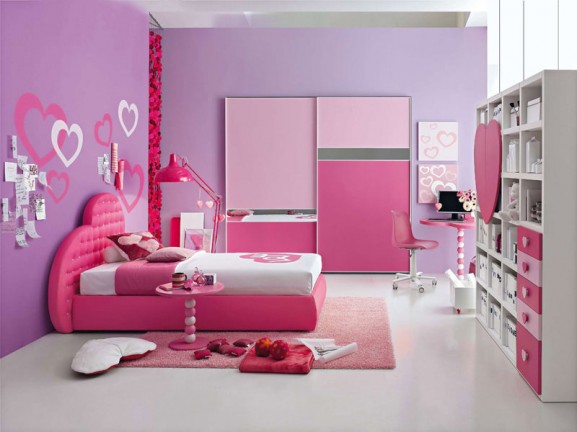
By Relocation.com
After all of the tasks related to moving are completed there is the question of decorating that you will have to deal with. Decorating a bedroom can be a fun bonding activity between you and your teenager. For a teen, their bedroom can be their sanctuary, and so you want to make sure it is a place where they feel comfortable in. You can be involved with making the decisions, but you should also consider what your teenager likes (if you don’t know – ask!) So, here are some quick tips to help you and your teen with this decorating task.
Budget.
Setting a budget is important, so you don’t go overboard and your teen will have a realistic expectation what he or she can do with their room. If you’re doing major renovations, then you’ll probably have to set a bigger budget than if you’re just going to paint or wallpaper the room.
Design and Color.
What type of teen do you have? Is she a girly girl or a punk rocker? Does he love sports or playing video games? Let your child choose what theme and design his or her room will be. Don’t let them decide everything; after all, it’s your home. For example, painting the room black may not be a good option if you plan to sell the house in a few years. Getting hot pink carpet may be your teen’s idea of a fun time, but think about how it will affect the value of your home. Have them come to you with different ideas and then you can choose together. The idea here is to compromise.
Space.
Aside from what color walls or accents you’ll have, you’ll also have to consider the space. Your teen will want a bed and a place to study. If you’re buying furniture, you have to make sure that they’ll have a place in the room. Storage options are also important. If the room doesn’t have a built-in closet, they’ll need a clothes closet. You’ll also need shelves for books and other things they want to display, and perhaps some out of the way storage for things they don’t use often or for seasonal clothes. Under the bed storage can help you save space in this case. If the room is large, maybe you can add an exercise or lounging area as well.
Accessories.
Much like in fashion, accessories can make or break a room. If you’re just doing minor decorating, things like curtains and sheets can really change a room. Get sheets, pillowcases, curtains, towels, even shower curtains that match your theme and design. Or you can add a touch of color with small things, like lampshades and carpets to make a big difference.
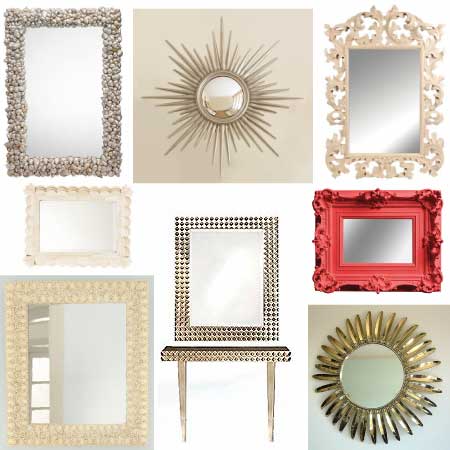
By Relocation.com
After you have settled in with moving you may be thinking about some ideas how how to decorate your room. A fun way to do so is with mirrors. A well-positioned mirror in a rooms can brighten it up, as well a giving it an illusion of space – perfect for diminutive spaces! So, if want to use mirrors for your home, check out these unique and creative mirror decorating ideas.
Create your own Design.
You can purchase mirrors cut out in different designs, but why not make your own? A sunburst mirror design will be perfect for any room, and you don’t have to break the bank (or a couple of mirrors) to do this. Take a large circular mirror, and several rectangular ones. Place your round mirror in the center, and then position the rectangular mirrors around it, making it the “rays” of your sun. You can also make other designs from pre-cut mirrors, just use your imagination!
Bathroom Decor.
Your bathroom should have at least a small mirror, usually over the sink. But, you’re not limited to that. If you have a small shower stall, you can install a full-length mirror inside to help create an illusion of space. You can also put a mirror on the walls or on the door, so you can give the bathroom a more open feel.
Light up Your Living Room.
If you have a small, cramped living room, placing mirrors inside will help you create that illusion of space. However, a more creative use would be help you light up the room. You’ll have to position the mirrors in such a way so that it catches and reflects light. One way is to take several full-length dressing mirrors and hang them horizontally in panels across your living room. This position catches the light and reflects them in interesting ways. Another would be to cover on side of the room with mirrors, and then place a couch in front of it. This creates a seating area and focal point for your living room.
The Bedroom.
A mirrored headboard is an interesting focal point for your bedroom. You can find several types in the stores or you can simply make your own. Of course, don’t just get a full-length mirror and turn it sideways. Do something unexpected, like taking small mirrors and positioning them to make a headboard. Or, you can take up the entire wall as the headboard and place mirrors all over. If you want something simple, a decorative round mirror placed above your bed can make an elegant statement.

By Maria Paulia Belgado
In the last few years, people have been concerned about the state of the environment – from global warming, to deforestation and saving endangered species, it seems every has “green” on their mind. So many things have “gone green,” from business practices, to the moving industry to fashion and even home decorating. Our homes are the best place to start if we want to be environmentally-friendly (as well as teaching our kids to be.) Of course, it’s not just about being chic and in-style, but you may find that keeping toxic materials and chemicals out of your home can do a lot more for your health. With these bedroom decorating tips, you’ll find that it can be easy to be green.
Clear the Air, Save Some Cash.
The quality of air in your bedroom is important; after all, you breathe it in and out for at least 8 hours per day. You can install from filters and air purifiers, but you don’t need to spend that much. One great way to clear the air is to install fans in your bedroom. These will not only save on your power bill, but also ensure that your air keeps flowing and doesn’t get stagnant. Also, get some lighter curtains that can allow the sun to stream in – sunshine is the best bacteria killer and will also prevent molds and mildew from accumulating in dark, damp bedrooms.
Green Your Bed.
The mattress is the most important part of your bedroom – make sure it’s not harming you and the environment. Many conventional mattresses contain toxic chemicals and contains polyurethane foam which is bad for the environment. Instead, choose organic mattresses, usually made of wool, cotton or latex which are all farmed organically. These are durable materials and provide the same comfort as regular mattresses, so there’s no need to sacrifice quality for eco-friendliness.
Don’t Forget Your Bedding.
Next, you can get some organic beddings, as well. Organic cloth made from cotton or bamboo are the best, as these are not treated with formaldehyde to make them soft. Cotton plantations use about a third of the world’s pesticides, so buying organic cotton, made without any chemicals will make a big difference. Bamboo, on the other hand, is a fast-growing, renewable resource. Of course, when you decide to go green and replace your old bedding, make sure you recycle them, whether that means turning them into something useful like pillow covers or rags, or donating them to a shelter.
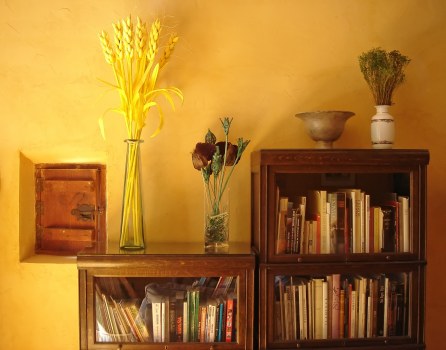
Follow our tips to brighten up and decorate your small space
With small apartments or homes, decorating your small space can be a challenge. Since your home is a reflection of your personality you want it to be warm and open showcasing your interests in music, art and culture.
Keep it natural. For small spaces, you will need maximum openings to help with natural light. Make sure your blinds and curtains do not block any artificial and natural sources of light; doing so will make your room look dry and cramped. Avoid using heavy and dark window curtain as they reduce the visual area of your room. Make sure you use clear or light colored glasses for your windows. Arrange your furniture such that it doesn’t block light. Sparkling clean windows will add more volume to your room.
Huge and block-like furniture pieces will your small rooms look even smaller. Try placing light and informal furniture pieces that make your small room stylish. Do not place your chairs or sofas in front of your windows. Placing furniture in front of your windows reduce the length of your small spaces. Low profile furniture pieces are best suited for small spaces. Make sure you add furniture which is comfortable and keeps free space in your room.
Monochromatic color schemes are best suited for small spaces. This means you should use different shades of the same color. This trick works best when you use a neutral color, like white, along with it. Using variations of a single shade make small spaces look larger, open and not cluttered. You may also consider adding exciting textures.
Even of your space is small, it should be converted such that it has enough place for everyone. There is potential in all small spaces to be converted into stylish areas. Even if your space is small, there are corners which can be used effectively. Add reading lamps or slender hall lamps to brighten up those corners. You can easily give volume to your small space by highlighting your dark corners. Setting slim and tall hall lamps will also throw light to your ceiling and make the entire room glow.
Keep your floor area clear. Using up floor space will reduce the area of your room. Adding shelves and wall racks will make your small space attractive and also provide better storage options. There are several kinds of materials which can used to create decorative shelves.
Your space should also be free of clutter. A cluttered space feels not only disorganized, but cramped as well. If you want to project more volume in your small spaces, art and accents should be sparingly used. Adding few favorite accents will do the needful. You may also shuffle your accessories to change the look of your small spaces. While adding paintings, make sure you add the ones which are rectangular and sleek. Don’t cover all your walls with paintings; there must be enough space between two paintings, and it will make it look less cluttered.
Decorating your small space doesn’t have to be difficult. Using a little creativity and imagination can transform your small spaces into livable and wonderful areas.

Check out some of our Thanksgiving decor ideas to spruce up your home for the big feast!
By Maria Paulia Belgado
Special to Relocation.com
It’s almost that time of the year – Thanksgiving! Everyone’s looking forward to the feast – the turkey with trimmings, stuffing, green beans, sweet potatoes and pumpkin pie. So you’re pulling out all the stops to get the dinner ready and sparing no expense. But, have you thought about your Thanksgiving décor? You want your guests to feel the spirit of the holiday, so you’ll have to get your home worthy of your amazing turkey feast, with these simple Thanksgiving decorating ideas.
Outside the Home:
First off, welcome your guests in style even before they enter your house. Make sure your lawn is clean and neat by raking all of those fallen leaves. If you have a porch, you can decorate your home with some large pumpkins, gourds or Indian corn in strategic corners, or you can use them to line the walkway to your front door. On your front door, hang a nice autumn wreath. You can get a pre-made one or do it yourself. Take some twigs and branches and form it into a circle; use zip ties or twine to hold it together. Decorate with leaves, pinecones, mini-pumpkins and other fall items. This will make a nice addition to your door.
The Living Room:
The living room is where you’ll be entertaining your guests before you sit down to dinner. It’s easy to decorate your living room by just adding splashes of color here and there. You can put some fall color throws on your couch, and some pillow as well. Place some more pumpkins, gourds and corn on your coffee table, arranges artistically to make a nice display. If you have a fireplace, make sure the fire is going when your first guests arrive. Also, serve hot chocolate or warm apple cider while they are waiting. Here’s another great tip – on one corner, put up a poster (you can have the kids help design it) where people can write down what they are thankful for. It will make a nice souvenir to keep, and a great tradition to start each year.
The Dining Room:
Of course, the dining room is where all the action will take place. You’ve worked hard on your feast, so make sure it has a fabulous stage. Take out your best china and silverware since it is a special occasion. Again, the gourds, corn and pumpkins can be placed in the middle, or you can use other fall favorites like apples, maple leaves, and dried flowers. Add a few candles as well, to bring a romantic mood. However, if you want something a little more elaborate, you can have cornucopia, the most traditional of all Thanksgiving decorations, that signifies a bountiful harvest. You can make it out of paper plates or buy pre-made ones, and it makes a beautiful symbolic centerpiece for Thanksgiving.
With a little creativity and some time, you will be able to make your home a beautiful backdrop to accompany your fantastic Thanksgiving feast.

Is your closet a mess? Check out these tips to help you get organized!
By Relocation.com
Storage can be small to almost non-existent in a small apartment. Your closet, whether it is used for clothes or other things, is mean to keep things in place and out of sight in order to keep your room clutter free. However, most people just pile their things into a closet, without thought of what it looks like. It is important to keep the inside of your closet neat as well. You’ll be able to keep your things neat and clean, as well as maximize your space so you can fit more inside. Here are a few tips so you can get started on getting your closet organized.
1) Clear it out.
If your closet is so full you can barely close it, then it’s time to get rid of some things. The easiest way is to start emptying your closet and placing things in piles or boxes – those things you should keep and things you should give away. Be impartial and practical when you decide on what to keep and get rid of. If you haven’t worn it in a year, chances are you’ll never wear it again. If you’re waiting to lose those 10 pounds to fit into your old jeans – don’t! Give it away and buy new, slimmer jeans if (or when) you do lose that extra weight.
2) Use every inch of your closet.
Are you using every available bit of space inside your closet? Shelving is important to make use of vertical space, and if you don’t have any built it, you can easily find stacking shelves that you can place inside so you can fit more items in. Look as every nook and cranny to find ways to add more storage. How about the closet doors? You can attach hooks to your closet door and hang shoes, scarves, belts, ties and bags.
3) Organize visually.
Use your eyes to organize. What does this mean? First, you should keep the things you need often at eye level, so you can easily get to them without disturbing the closet’s organization. Next, organize things by color. That way, if you’re looking for a particular red shirt or yellow dress, your eyes will be drawn to that particular corner of your closet and you can quickly get to it. The same can be said of organizing shoes. Keep them in clear boxes so you know what’s inside, or else, take a photo and place it outside the box so you know which is which.
With these organizational tips, you can easily maximize your closet space and keep your things in order. With a neater and orderly closet, you’ll be able to access the things you need easily and keep you space from being cluttered, which may also make moving that much easier.

Spruce up your home with some curb appeal
By Relocation.com
Your front yard is one of the first things a homebuyer will notice. You may have brand new kitchen appliances, or have excellent hardwood floorings, but if you don’t have curb appeal, buyers may not be interested in checking out the interiors of your home. One of the best ways to reel in potential buyers is to curb appeal. Here are 10 ideas to make your curb look attractive.
1.) The exterior home: Before starting on your yard, check the physical appearance of your house. Take a look at the entire neighborhood and get a general idea about colors. Try and choose colors that stand out among other houses but are not very loud. Pressure washing bricks and curbs is also an excellent idea.
2.) Highlight your home: Make sure to accentuate the features of your home. If you have a drive way you could install lights or have decorative pillars that lead a way to your home. Having beautiful plants and shrubs will also add in curb appeal.
3.) Interior decorations shouldn’t hamper the exterior appeal: Several homeowners decorate their home such that they hamper the exterior beauty of the house. Your interior furniture and fittings should not be seen if you are standing on your curb. Your curb should be an extension of your interiors but it should have its own identity as well.
4.) Entry areas and walkway: Your entry areas and walkways are one of the most important factors of your home. You can improve the look of your sidewalk, driveway, and stairs around your house by removing all debris, weeds, and washing your pavement. If you park cars on your driveway, make sure you clean all oil and petrol stains.
5.) Keep unsightly items away: Curb appeal is associated with the way your family lives. Garbage cans, debris, trash bags, and gardening tools must be kept away from your curbs. These items will give your house an unkempt look, and help homebuyers form negative opinions about your home.
6.) Manicured gardens: Make sure your grass is cut and trimmed at regular intervals. If you have flower beds or shrubs, they must be watered and cared for. For dead and dry spots on your garden, you can buy garden fixtures and hide them.
7.) Constant care is essential: Caring for your home must be a part of your daily routine. If you start caring for your house because buyers are coming, the effects may not have the same impact as maintaining it.
8.) Replace old items: Things like mailboxes, number plates and hardware that are installed in around your house have a major impression on the buyers. Buy new elements to replace the older ones.
9.) Spice up your outdoor furnishings: The appearance of your outdoor and patio furniture should be fresh and clean. These are considered leisure areas and should always appeal homebuyers.
10.) Add exciting colors: To get curb appeal, you must consider adding some color to your yard. Getting in colorful flowering plants and furniture will add additional color to the exterior section of your home.

By Maria Paulia Belgado
Special to Relocation.com
The holidays are upon us again, and first up is the frighteningly delightful celebration of all things ghoulish – Halloween! It’s that time of year when the young (and young at heart) dress up in celebration of All Hallow’s Eve. Dressing up isn’t just for your kids – you can dress up your home as well, to welcome trick-or-treaters or guests for a Halloween Party. To help you along, here are some Halloween home decorating ideas to give your home a festive new look.
Idea #1 Scary Carved Pumpkins:
Pumpkin carving is a Halloween tradition, and is a great activity for kids (though the young ones should be supervised!) If you’ve never done it before, it’s easy to make your own Jack-O-Lantern. Take a fresh pumpkin – the bigger the better – in a shape you like. Draw a circle on the top, around the stem, and cut carefully. Take the top off and set it aside. Scoop out the insides and throw it out. Now, draw a scary face on the side of the pumpkin, and carefully cut it out it a small knife. When you’re done, place a small votive candle inside and put the top back on. And there you have – a pumpkin carving worthy of Halloween! Do this with several pumpkins and place it along your porch or front yard to greet your guests.
Idea #2 Spooky Scarecrow:
A scarecrow isn’t just for the birds – but it can be fun for Halloween too. First, carve an extra pumpkin (same instructions as above) and set it aside. Take some old clothes, like a shirt and pants or overalls, and stuff it with straw. Sew the top and bottom together to make the scarecrow body, and cut out a hole between the legs. Then, drive a large stake to the ground, and push your scarecrow body through the stake, leaving some room on the top. Secure it with some twine if you need to. Now, take your carved pumpkin, cut a hole in the bottom for the stake, and place it on top of the body. Top it off with a straw hat and there you go – a spooky scarecrow to frighten (and delight) those trick-or-treaters!
Idea #3 Holiday Wreath:
Not all Halloween decorations need to be scary. Halloween is also when fall is in full swing – when the leaves turn brown and fall to the ground and crunch beneath our boots. Celebrate this time of the year with a holiday wreath. It’s really easy to make, if you have the right materials. You’ll need a circular frame of some kind, and you can cut one out of Styrofoam or you can use an embroidery hoop. Using crafter’s glue or a hot glue gun, you can attach all kinds of fall-related items to the hoop. It’s good to have a base material of some kind, and usually, brown twigs are a great base. Just take the twigs and glue it to the frame, in the same direction. Then you can attach all kinds of things to it – pine cones, leaves, miniature pumpkins, small ears of corn, etc. Or if you want to keep with the spooky Halloween theme, then you can use plastic spiders, vats, skulls or mini Jack-O-Lanterns.
These are just some of the basic home decorating ideas for Halloween you can do to prepare your home for this fun and frightening holiday. Be creative and try your own decorating ideas – there are no rules and remember it’s all for fun!

Keep cool this summer without raking up your electricity costs.
By Stephen Davis
Special to Relocation.com
In the summer, electricity bills can increase – especially in warmer areas in the south and west. During such periods of heat electricity consumption needs to be kept low. The key to this is efficiency and to use resources wisely.
One of the first things that you should remember is to keep your shades and blinds closed. This prevents the sun from heating up your home and wasting energy. Incandescent bulbs and other similar light sources also produce heat just like the sun does, so it is better that you keep extra lights off. A dark area generally gives a cool feeling anyway.
Hot air rises, so keep the vents and windows of the lower rooms closed. This will give the rooms upstairs more air and keep them ventilated and cool. Keep the vents and windows of the upper rooms open to the hot air escapes that way.
Also find out the sources of heat in your house. Cloth dryers use a lot of electricity and in addition to that, they also produce a lot of heat. Always install dryers near a window and have an air pipe made or an exhaust fan installed to channel away the hot air. Dryers that are placed in basements should have proper ventilation too or the hot air will escape into your living room through the stair case.
You should take a tour of your house and examine any openings from where cool air might escape. Remember cool air is heavier and will escape from places closed to the floor. This includes the spaces under doors. Some doors have a large space underneath them. This wastes a lot of cool air. Install strips of carpet or rubber at the door edges to act as a barrier to the cold air.
Human bodies also produce heat, especially during active actions like exercises. Do not do workouts indoors. Use your lawn or the local gym. The less activity there is inside the house, the cooler it will stay.
Many people keep on changing the air conditioner thermostat. This isn’t a wise idea as it uses more energy. Keep the air conditioner at one constant temperature. It will always cool better that way and consume less electricity as well. If you have a central air system, keep the fan on “On” instead of “Auto”. This will keep a steady airflow through your house and maintain the temperature beautifully.
Use pleasant weather wisely. Place a box fan in a window early in the morning and open the opposite window. This will circulate the fresh morning air through your house and cool it down.
In many areas, the air conditioner is not really necessary. Learn to live without it unless absolutely necessary. In many cases, the ceiling fan can do a nice job by itself.
Try if it works. Using less air conditioning will bring down electricity costs considerably.
And by the way, since it is the summer; go outside. Visit the beach, lake or riverside. Go to water parks and have picnics with friends. When you leave, make sure everything is turned off.
Don’t forget to like us on Facebook and follow us on Twitter!
• Follow us on Twitter @Relocation_News
• Become a fan of Relocation.com on Facebook

By Dermound Becker
Special to Relocation.com
For many, gardening is one of life’s greatest pleasures. When considering what plants should go into your garden, herbs are an excellent choice. Not only are they a boon for your culinary skills, but they all come in varying shades of green, have differently shaped leaves and lovely scents, thus making your garden interesting to look at too. It should also not be forgotten that certain herbs can be used for natural remedies and cures. If you need some herbs in cooking, you simply cut off the amount you need and the plant will show no signs damage and its growth will not be hindered.
Parsley. One of the most versatile of all herbs is parsley, which is used in many recipes. It grows in clumps of bright green stems and leaves up to a height of around one foot. Parsley is known to keep away the common house fly which is good enough reason to plant this hardy herb.
Rosemary. Rosemary is a very strong and hardy herb which needs little water and thrives in direct sunshine. It grows in bushes with fronds of thin, elongated leaves and, in spring, has dainty little lilac or purple flowers along the length of its fronds. Rosemary is known as the calming herb and one can simply steep it in boiling water for a few minutes and, when cool, sipped; and this ‘tea’ is also a mild antiseptic.
Chives. Chives make a pretty addition to a small garden. A part of the onion family, it has a mild flavor. Chives are a bright, strong green and they grow vertically in long, thin blades similar to grass, which make a good visual contrast to other bushier herbs.
Basil. Also known as sweet basil, is another popular small garden herb as there are green, red and purple varieties, which add a color contrast to your small garden. The red variety has small pink flowers; and this herb grows low on the ground, thus making it great for a border.
Mint. Finally, mint adds a lovely fresh scent and bright light green leaves to your herb garden. Mint is another herb which keeps away the house fly and its other uses are many. It is used to make a tea by steeping it in boiling water; and may be added to traditional tea and lemonade. Mint can grow quite tall, so it should be planted at the back of your herb garden and it needs to be trimmed occasionally, as it can grow out of control.
These herbs can be planted either in the soil of a small garden, or in individual pots and arranged in an attractive formation. As they are all hardy, they can be dug up with their roots to be transported to another location or, if in pots, wrapped in bubble plastic to protect them when being transported.
Don’t forget to like us on Facebook and follow us on Twitter!
• Follow us on Twitter @Relocation_News
• Become a fan of Relocation.com on Facebook

Follow our simple tips when learning how to compost.
By Maria Paulia Belgado
Special to Relocation.com
Whether you own a country cottage that has large gardens or a posh city apartment with a few flowerpots, you should consider composting to benefit both your garden and the environment. Composting is essential, as it keeps waste products away, and fertilizes the land without any chemicals. It works by degrading plant substances into humus, which is very rich kind of fertilizer. In simple terms, composting means recycling plant products to create something useful.
There are several ways of creating compost. These include heaping up leaves and hay and allowing the pile to decompose. However, if you wish to decompose kitchen waste, try mixing dry and wet scraps in a silo and allow it to be aerated. This will create heat and help with the decomposition. This process can be used by apartment dwellers. However vermin composts are best for people living in flats. In vermin composts, essential bacteria decompose kitchen scraps into smaller particles and create food for the worms. In turn the worms excrete moist, odorless and rich compost.
There are several kinds of worms found for this purpose, but most use the red wigglers. These can be purchased online, or from bait shops and garden centers. After you have bought the worms, cut a newspaper into thin strips and place it at the bottom of a container, and moisten it with some water until it’s damp. Then, place the worms and the mud that came along with those. Cover the container and place it in a cool and dark place, making sure the temperature is not too hot or too cold.
Now is the time to feed those worms. Put in kitchen scraps and cover with mud in one corner. After a few days, add more scraps in another corner. Rotate these corners every time. The first will be ready by the time you reach the last one. Whenever you add wastes, make sure you bury in rotation. Few months later, there will be less paper and lots of crumbly, brown stuff in the container. The compost is ready. Once the compost is ready, you can easily scoop it up and use it. To create a new set of compost, clear all the materials of the container and repeat the entire process again.
If you want to have good quality compost you should also avoid garlic, spicy and salty stuff, which are poisonous for worms. These worms will reproduce while they are decomposing your scraps. In case of overcrowding you can donate those worms to schools, bait houses or to a plant nursery.
All of these methods mentioned above are really low-maintenance and easy for you. The best thing about composting is that it is free, fabulous and extremely useful for your plants. The humus you create from your own wastes and scraps will help your plants stay healthy and thrive well.
Don’t forget to like us on Facebook and follow us on Twitter!
• Follow us on Twitter @Relocation_News
• Become a fan of Relocation.com on Facebook

Recycling is a great way to start with your budget home designs.
By Maria Paulia Belgado
Special to Relocation.com
When decorating your home, have you thought about the impact your decisions make on the environment? These days ‘going green’ usually means paying a premium, just to save the environment. Organic food, biodegradable packaging, eco-resorts – all these things cost at least 25 percent more than their regular counterparts. However, no one said this was a rule – in fact, doesn’t it seem silly in a way, that to be environmentally friendly has to cost more?
But, you don’t have to spend a lot just to save Mother Earth. In fact, you can still be eco-chic, without breaking the bank, with these green design ideas:
First things first – recycle!
Don’t just throw out everything you own. See if there’s anything at all you already have that can be reused in any way. Maybe all you need to spruce up your living room is some new pillows. You can sew new pillow covers using fabrics you have lying around the house. How about those pretty curtains you’ve never put up or maybe some pretty scarves which have gone out of fashion. Before you go to the store and reach for your wallet, look around the house first.
Also, you don’t have to buy everything 100 percent brand new. Go to thrift shops, the Salvation Army or garage stores and turn someone else’s junk into your treasure. You’ll never know what fun and unique items you’ll find, at cheap prices too!
Repaint.
One of the cheapest ways to really change up a room is with a coat of paint. Choose eco-friendly, non-toxic paint with low or no VOC (volatile organic compounds). These might end up costing a little bit more, but instead of calling an expensive painting company do it yourself! This way, you can save money and you can reduce your carbon footprint since you don’t have to ask someone to come in and drive to your home.
Make your own décor.
Why pay a lot for artwork for your walls, when you can make it yourself? Have your own photos done at your local printshop and frame it, so you can hang it on your empty walls. Or why not assemble some old jars and bottles, fill them will pretty stones or seeds and use that as an accent or centerpiece? Eucalyptus leaves last for a very long time and can be used to decorate your bathroom, as well as give you some natural aromatherapy. Cut some stems and wrap them at the end with some recycle ribbon or string. Hang it upside down your shower curtain rod to bring some real green into your bathroom.
Think small.
There’s no need to replace your entire kitchen or living room and spend a fortune just to be eco-friendly. Replace your light bulbs with more energy-efficient ones. Or why not get some inexpensive heat-inductive cookware – these make sure your food is heated up evenly, and therefore you use up less energy to cook. Instead of using harmful chemicals to clean your countertops, use some good ol’ vinegar and water.
There’s no need to blow your budget, especially in today’s tough economic times, just to go green. By thinking creatively, you can save a lot of money, have an eco-chic home and help save the planet.
Don’t forget to like us on Facebook and follow us on Twitter!
• Follow us on Twitter @Relocation_News
• Become a fan of Relocation.com on Facebook

Now that the kids have moved on it's time to think of how you will remodel their old room.
By Faith Teel
Special to Relocation.com
It’s that moment that every parent looks forward to with excitement and dread: your child has gone off to college or moved into their own apartment. Their room is empty, the bed is always made and no rock music comes blaring through the walls. Now what?
Whether this is a sad moment because you miss your child, or a happy one because the house is more serene, or a little of both, you still have to decide what to do with their room. Even for parents that miss their kids, the best course of action may be counter-intuitive: many experts recommend remodeling the room for a new purpose so that it doesn’t constantly remind you of the past.
If you are concerned that your child won’t feel welcome when he or she returns for a visit (or for summer break), you can discuss the changes with him (or her). Here are a few things to think about before you have your talk:
• Will your child want any of the furniture in the room? If not, can the furniture be re-used, or should it be sold or thrown away?
• If he or she has left keepsakes behind, what can be thrown away? What can be stored? Consider displaying the most precious items (such as trophies or pennants) so that your son or daughter still has a place in your home.
• As you update the room to suit your tastes, can you make concessions to your child’s taste? For example, if you want to paint the walls gray but your daughter loves pink, perhaps you could add pink accents in the lamps or curtains.
As you decide how to redecorate the room, think about how your life will change in your child’s absence. What hobbies will you pursue? Will you exercise more? Once you have a grasp of how you’ll use all of your new free time, you can update the room to accommodate your new lifestyle.
Here’s what other “empty-nesters” have made in their extra space:
1. A home office:
Whether you’re thinking of starting your own business or just need a place to keep your bills, a home office can help you stay organized.
Suggested amenities: add a computer desk, computer chair, shelves and filing cabinets.
2. A sewing room:
Experienced sewers know that you’ll get more done if you can keep your sewing machine out where it’s easy to access, instead of having to pack it up each time you finish a project.
Suggested amenities: add a sewing table, cutting table, quilting frame, thread organizer, shelves for storing fabric.
3. A game room:
Do you and your friends get together to play poker or Uno? Why not set up a place for social card games?
Suggested amenities: add a card table and chairs, mini-fridge, game-themed decor and the games themseleves.
Tip: Don’t go overboard and buy every single game out there. Pick three-five of your favorites and make it a point to have friends over once a month for an organized game night.
4. An art studio:
Have you always wanted to tap into your creative side? Now that your kids are grown up (or almost grown up), you may have more time to paint or craft.
Suggested amenities: add corkboards for pinning ideas to, tables or easels, shelves to store supplies, a clean-up sink (for painters), paint, brushes, etc.
5. A media room:
Do you love to watch movies? Why not make your own home theater? The room can have furnishings as simple as a couch and a television, or you can go wild with theater seats and surround-sound!
Suggested amenities: room-darkening curtains (for watching during the day), comfortable seating, a DVD player, etc.
6. An exercise room:
Perhaps you already exercise regularly, or perhaps you’ve been putting it off. Either way, you’re more likely to keep in shape if you have a pleasant space for your daily workout.
Suggested amenities: exercise mat, exercise equipment, inspiring pictures and a music system.
7. A large closet:
If you have a big wardrobe crammed into a small closet, consider making the bedroom into a luxurious walk-in closet.
Suggested amenities: cedar wall panels (an easy DIY project), sturdy closet rods and hangers, mirrors.
8. A “man cave”:
Does the gentleman of the house need a place to watch football games or finish his latest project? If so, consider remodeling the room to suit his tastes and needs.
Suggested amenities: mini-fridge, sound system, TV, comfortable chair, shelves and tables for hobbies.
Whether you’re planning an art studio or installing a home theater, your redecorating budget doesn’t have to be large. Scour Craigslist and yard sales for perfect finds, and don’t be afraid to repaint and reuse your child’s old furniture. In many cases, you can cut down on costs by keeping the flooring as-is. Reclaiming your space can enrich your life without draining your wallet.

Congratulations on moving in - now it's time to unpack and finally settle in.
You did it – you finally moved it! Although the moving companies are long gone you now have a sea of moving boxes, unpainted walls and a bare home to deal with. Before you go crazy with the unpacking, we advise setting up a plan so that you can quickly settle-in and enjoy your new home.
1. Go out to dinner. No, this isn’t a plot to aid in your procrastination. We simply think that taking break after the days (and sometimes months) leading up to a move is a healthy way to re-focus on your plan. Getting out of the house is a great stress-reliever that will (hopefully) allow you to think about something else other than those boxes at home. Plus, having a relaxed dinner is also a great way to check out a restaurant or neighborhood in your new town or city.
2. Make it a party. If you can’t manage to break away from your unsettled home, consider having a painting and/or unpacking party. This will allow you to ask for help by offering your friends food and drinks as well as they help you in making your house a home. Make sure you tell your friends to wear old or ratty clothes –painting isn’t pretty but it can sure be a lot of fun.
3. Unpack with purpose. Moving is a great time to unpack in an organized manner – meaning not just leaving your items unattended to for days, or the worst case, leaving them in boxes and shoving them in a closet! If you find that you don’t have room for certain items, consider storage or maybe giving them away. You want to establish a fresh start in your new place and not a continuation of the way you were living.
4. Don’t overdue it. Everyone wants to be settled into their new home and neighborhood as quickly as possible. The problem when you try to do too much is complete burnout. Give yourself a schedule – allotting time for breaks outside of the home. Sometimes what you think you can do in a week will actually take two or even three weeks. Don’t let this stress you out and realize the hard part (moving) is over.
5. Celebrate. We mentioned going out to dinner and having a painting party, but now that you have unpacked and decorated it’s time to really celebrate with a housewarming party! Invite friends in your area for a casual evening of food and drinks. If you are completely new to an area, have a small dinner party with just you and your partner and/or roommate. However you celebrate, make sure you site back and finally enjoy the fruits of your labor.
March 21st, 2011 by
Admin
Categories:
design and decorate,
Do It Yourself,
exterior projects,
Home Improvement,
interior projects,
Moving,
Moving Day,
Moving Industry,
self storage,
Storage,
storage facilities,
storage units Comments:
No Comments » 
Arm yourself with an arsenal of cleaning products to tackle spring cleaning!
By Serena Norr
It’s officially spring! Even though it’s still pretty cold out there, we are getting excited about shedding our bulky winter coats, getting a much-needed dose of Vitamin D and cleaning out our homes for the season. Spring cleaning is a great way to get rid of items that you no longer need by donating, tossing them or placing them in storage – making your home more functional and organized. Here are some simple tips to make your house a lean mean clean machine this spring.
1. Start with the windows. An often neglected part of any house, the windows are also the easiest places for dirt and grim to acclimate. Using a rubber-edge squeegee or a sponge, mix a bucket with water and some window cleaner. Wipe and repeat until the windows are spic and span. You may also need to use a dry cloth afterward to ensure that you removed all of the dirt. While your doing this make sure you also wash your window blinds and/or curtains.
2. Change your linens. Do you have frayed and broken down linens? Spring is a great time to try new patterns and update your home with lighter and brighter colors (think feel good colors for summer!) We love flowing duvets with pale greens, yellows and lavenders.
3. Clean the refrigerator. Your fridge should really be cleaned all the time, but the winter has a way to make it easier to acclimate containers of old food – leading to mildew and pretty nasty smells. Even if you do throw out old boxes of Chinese food before it goes bad, you (most likely) aren’t rigorous about cleaning out your entire fridge. Start by taking everything out (yes, we mean everything) and throw out anything that is old or has a strange smell and/or resembles something of a science project (e.g. mold). Remove the drawers and shelves from the fridge and wash off any dirt, crust or old food. You can also scrub difficult-to-get areas with a scrub brush and/or an old toothbrush. Throughout the spring and summer get in a habit of regularly cleaning your fridge and freezer by making it a part of your normal cleaning schedule (about twice a month).
4. Clean those rugs. Rugs and carpets can very easily acclimate dirt and dust (even if you regularly vacuum). In the spring, deep clean your rugs or carpets by using a strong cleaner or hiring a professional cleaning company. Since these solvents are pretty strong, be sure to keep the windows open and try to avoid staying where the carpets are for a few hours. If you don’t have rugs, make sure to sweep, scrub and mop your floors.
5. Go through your closet. Ah, the closet, the quintessential dumping ground for all seasons. Use the spring as a way to de-clutter your closet and make some sense of the mess. Start by removing any winter items – like bulky coats and sweaters – and place them into boxes for storage or storage bins to be placed under your bed or in your garage. If there are items that you don’t need (or really never use), consider this a time to get rid of them once and for all by donating them to a local charity or give them to friends and family members. Since it is getting warmer, you may also want to sell them at a garage sale. It’s up to you how you get rid of them but the main thing is that you actually get rid of them. This also applies to shoes, bags, belts and the random knick knacks that often have a way of getting tossed into closets.
6. Junk draws no more. Junk draws are called junk drawers quite simply because they are a nesting ground for all the random things in our homes. Instead of making it all about junk, make these drawers practical and useful. Start by taking everything out of your drawer in order to clean it. Look through the contents and decide – what you really need and what is just garbage. Is your drawer filled with random nails or old tape? If you don’t need it, you may want to toss it. Oftentimes these useless items just live in our drawers until moving day. You may also consider purchasing a storage unit for your drawers in order to keep your items organized and neat.
7. Don’t forget these drawers. Cleaning not only applies to your junk drawer but should apply to your medicine cabinets, silverware drawers, cupboards and clothing drawers. Get rid of any expired medications, clean your silverware and go through your cupboards for old food. You should also go through your clothing drawers – they same way you did through your closets – and get rid of anything you no longer need or use.
8. Update your look. Just like update your style, you should also do the same for the look of your house. Your home is a place to seek refuge and find comfort and you can’t find such peace in a home with dreary colors or one that has dirty walls. Start by washing and scrubbing the walls. Then decide on a new paint scheme. Before you paint the entire home, be sure you know your vision and what “look” you want for your new home. You can purchase samples of a color or bring home color swatches before you make your final decision. Also, look through magazines and cut out pictures that resemble the look you want. After you paint, consider hanging up artwork and/or family pictures to give your home a personal touch.
Spring cleaning isn’t easy and sometimes can’t be fun, but it is a great way to shed some excessive junk from your home as you lighten up for the summer. You will not only feel better about losing these unnecessary layers of junk, your home will look brighter and become more functional – making it truly a place to find comfort.
Other areas to clean:
- Attic, garage or any other home storage units
- Home office
- Light fixtures
- Outdoor area
- Kid’s rooms
Don’t forget to like us on Facebook and follow us on Twitter!
• Follow us on Twitter @Relocation_News
• Become a fan of Relocation.com on Facebook

Moving Announcement Cards by Tiny Prints. (Image Credit: Tiny Prints)
By Serena Norr
Congratulations on your exciting move. This will be a (very) busy time for you as you research and locate movers, pack, and of course, leave your old home. Another thing on your growing to-do list should include letting your friends and family know that you are moving by announcing your move and providing them with your new contact information (address, phone number, email address, etc). One way to do so is by sending out a moving announcement either as a postcard or through an e-card – here are some of our favorite options.
1. Tiny Prints. The adorable moving announcements by Tiny Prints feature a wide-range of styles and patterns from contemporary and modern to more traditional cards to announce your move. We love the Simply Understated: Basil Cards and the Beep Beep Bug: Agua Cards that allow you to add a picture. The price for these moving announcements is also right averaging around $1.00/per card.
2. Purple Trail. With everything involved with the moving process, ordering and sending out cards might not fit into everyone’s schedule. As a website, we love quick and simple and found that on PurpleTrail.com. This online invitation site (they also offer cards you can order and mail out), features over 50 moving announcements that you fill out in their browser. You can add a personal message, upload photos and add creative design elements from Purple Trail’s library. Even better? Purple Trail is a free service when you send 75 cards or less.
3. Make your Own. For those craft mavens out there, consider making your own moving cards. This definitely requires some planning (and time) but if you are able to manage both then making your own cards can be a fun way to announce your move as you add your own personal design and flare. This can also be a fun project for kids and a great way to keep them busy while you are dealing with the organizing of your move. In your own cards, be sure to include your forwarding address, new phone number and email address.
Don’t forget to like us on Facebook and follow us on Twitter!
• Follow us on Twitter @Relocation_News
• Become a fan of Relocation.com on Facebook
February 2nd, 2011 by
Admin
Categories:
Celebrity Real Estate,
condos,
design and decorate,
Do It Yourself,
family moving,
foreclosures,
Home Improvement,
homes for sale,
House Swap,
Moving,
Moving Day,
Plan Your Relocation,
Real Estate,
Relocation,
Relocation Data,
rentals Comments:
No Comments » 
Gorgeous views from Katay Sagal's former home - sold for $3.77 million. (Image Credit: Housing Watch)
By Serena Norr
We saw some exciting properties listed on the celebrity real estate market this week. Starting with novelist Truman Capote whose Brooklyn Heights home was recently listed on the market for $15.9 million – a drop from its original listing of $18 million. Considered one of the most expensive homes for sale in Brooklyn, the gorgeous Greek Revival is said to be the home where Capote lived from 1955-1965 and where he also wrote “In Cold Blood” and “Breakfast at Tiffany’s.” Kate Moss, the professional waif was also on the Beat this week for purchasing an historic mansion in London. Once owned by several literary figures, the home is situated on Highgate Hill and includes seven bedrooms and seven fireplaces – among many other attributes of this four-floor mansion. There were also numerous homes placed on the market from Los Angeles such as Rose McGowan’s Spanish-style home and Kyle Richards’ (of the Real Housewife fame) Los Angeles cul-de-sac and we are eager to see who purchases these hot properties. Until next time…
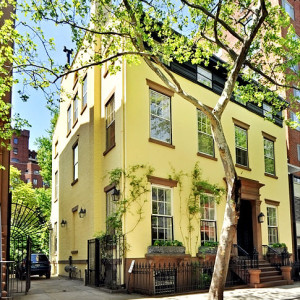
Exterior shot of Truman Capote's Brooklyn townhouse - Listed for $15.9 million. (Image Credit: Sotheby's International Realty)

Four flights of stairs in Truman's former townhouse
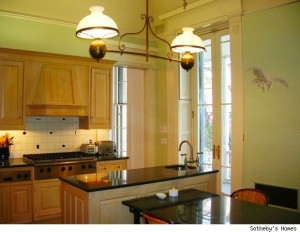
Kitchen in Truman Capote's former home. (Image Credit: Sotheby's International Realty)
• Truman Capote’s Brooklyn Home Drops to $15.9 Million
Truman Capote’s former Brooklyn Heights residence was recently placed on the market for $18 million – only to see a recent drop to $15.9 million. A Greek Revival townhouse, built in 1839, the 9,000- square-foot home includes 11 bedrooms, 11 fireplaces, columned porches, mahogany staircases, two kitchens, crystal chandeliers, an artist’s studio, a library and a gorgeous garden. The sale of the historic home is being maintained by Sotheby’s Realty that is said to be the most expensive townhouse for sale in Brooklyn. Capote lived in the home from 1955-1965 where he wrote “Breakfast at Tiffany’s” and “In Cold Blood.”

Exterior shot of Rosie McGowan's home - Listed for sale at $1.8 million. (Image Credit: The Luxist)

Rose McGowan's living room- Listed for sale at $1.8 million. (Image Credit: Housing Watch)
• Rose McGowan Lists Los Feliz-Area Home
Actress Rose McGowan recently listed her Los Feliz-area home for $1,849,000 million. Purchased in 2004, the home features both Spanish and Moroccan architectural elements that cover the four-bedroom with wood doors, three-bathroom home. The vintage-inspired home also includes a formal dining area, arched windows and 4,278-square-feet of living space. The home also includes a renovated kitchen and dining room and French doors that opens to a balcony on the second floor.

Katey Sagal's Kitchen - Sold for $3.77 million. (Image Credit: Housing Watch)

View from the pool of Katay Sagal's former home.
• Katey Sagal Sells Her Hollywood Hills Home for $3.77 Million
Actress Katey Sagal and her husband Kurt Sutter have recently sold their spacious Los Angeles home for $3.77 million to Rickey Minor, former music director of “American Idol.” Measuring at over 7,202-square-feet, this five-bedroom, eight-bathroom home is located on a gated property that leads up to the wooded hillside property. Built in 1962, the home is situated on 1.5 acres of land that also includes a dining room, a two-sided fireplace, a built-in contemporary breakfast area and an outdoor area with a basketball court, swimming pool and spa that also happen to overlook the gorgeous LA hills and the ocean.

The new mansion Kate Moss purchased for £7,950,000. (Image Credit: The Real Estalker)
• Kate Moss Buys a Historic Literary Mansion in London
Model Kate Moss recently purchased a 6,728-square-foot home in London for £7,950,000. Situated on Highgate Hill, one of the highest points in London, the mansion is considered an historic home where numerous literary figures once lived. The historic four-floor home includes seven bedrooms, seven fireplaces, two kitchens and four full-sized bathrooms. There is also a wine cellar, boiler room, storage space and guest quarters that includes two bedrooms, two bathrooms, a laundry room and a kitchen/dining area. Moss also owns a 10-bedroom farmhouse in Little Faringdon and a property in St. John’s Wood/Primrose Hill area of London, which is expected to go on the market shortly.

Kyle Richards' Hollywood estate - Listed for sale at $2.4 million. (Image Credit: The Real Estalker)
• Kyle Richards, a Real Housewife of Beverly Hills is Looking to Sell
Kyle Richards of the “Real Housewives of Beverly Hills” recently placed her four-bedroom, five-bathroom home on the market for $2,450,000. Located in Los Angeles, the 4,200-square-foot remodeled home also includes a formal dining area, an office and a resort-style back yard with a pool, barbecue area and a spa. The home, located at the end of a quiet cul-de-sac, was first listed for sale in 2009 for $3,450,000, which later dropped to its current listing price.
January 26th, 2011 by
Admin
Categories:
Celebrity Real Estate,
condos,
design and decorate,
Do It Yourself,
exterior projects,
foreclosures,
Home Improvement,
homes for sale,
House Swap,
interior projects,
Mortgages,
Moving,
Moving Industry,
Packing,
Real Estate,
Relocation,
rentals Comments:
No Comments » 
Moving to the city or the country? Read our detailed list about the pros and cons of both.
Transitioning Between the City and the Suburbs?: Here’s What You Need to Know about Making the Move
By Faith Teel
Special to Relocation.com
As the old saying goes, “The grass is always greener on the other side.” Whether you’re headed out to the wide-open spaces of the suburbs or moving into the exciting neighborhoods of the big city, you might find that you’ve gotten more than you’ve bargained for. Here are just a few examples of the things they don’t tell you in the advertisements.
Moving to the Suburbs
Long Commutes and Distant Stores – Many people move to the suburbs in search of more space to raise a family or grow a garden. Unfortunately, there is a flip side to having more space: everything is farther apart. Your commute will probably be longer, and you’ll have to drive, because most suburbs are too spread out to make public transportation cost-effective. In some places, it’s common to have an hour-long commute in each direction, which may mean 10 hours that have disappeared from your week.
The lack of public transport also means that you’re more likely to encounter the greatest terror to ever stalk the streets: the teenage driver. In cities, teens can often walk or catch the bus to socialize, but some suburbs are so spread out that a jog to the local coffee shop would be a three-hour marathon. Suburban teens usually get cars long before they get good judgment about driving them.
A Cultural Vacuum – One of the first things that urbanites miss when they move to the suburbs is the variety that cities offer. Many suburbs are extremely homogenous, with cookie-cutter houses and cookie-cutter restaurants. Even the people often seem the same, because few suburbs are economically or ethnically diverse. Don’t bother to look for museums, and feel lucky if a few of the chain restaurants offer take-out or delivery.
Where Are All the People? – The very privacy that you came looking for can also be your downfall in the ‘burbs,’ because everyone around you moved out here for privacy as well. With everyone so spread out, it can take a long time to meet new people.
Crime is Everywhere – Yes, there is usually more crime in the city, but the suburbs are not exempt from it. There’s lots of petty theft in suburbs, and there are still gangs and drug use in the high schools. Your kids are less likely to get mugged, but that doesn’t mean you should leave your doors unlocked at night.
The Grating Outdoors– One of the biggest surprises for ex-urbanites is the proximity of Mother Nature in the suburbs. If you’ve never had to mow a lawn or check the kids for ticks, you’re in for quite an experience.
Moving to the City
No Space – The city is an exciting place to be and a great place to find work, which is probably why you want to be there. Unfortunately, everyone else wants to be there too, and that drives up the price of real estate. If you want to live in a reasonably safe neighborhood, be prepared to pay through the nose for a tiny apartment.
For the same reasons, city parking is often impossible. People often sell their cars when moving to the city, which means you will have to rely on public transportation such as buses and cars.
Other People – Other people are everywhere in the city, and that can take some getting used to. Traffic is often worse, but the real nuisance is the noise, smells and constant crowds.
Goodbye, Mother Nature – It can be hard to get in tune with nature in the city. The parks are often crowded with other people (see above) and some may not even be located within a close distance to your home. If you manage to score a balcony or small yard with your apartment, keep in mind that the pollution can be hard on plants and trees. It’s also tough to keep animals in the city, especially big dogs that need room to roam.
School Roulette – In the city, it’s easy to get to know other parents, and you’ll need this advantage when it comes to getting your kids into a good school. In the suburbs, getting into the right school is usually a matter of buying a house in the best neighborhood. In the city, finding the right school is a combination of luck and strategy, and every city’s rules are different. You won’t even have to raise this topic at your kids’ next playdate, because it will be the first thing on every parent’s mind.
Abrupt Changes in Neighborhoods – With everything in the city so packed together, it can be hard to tell at first glance which neighborhoods are safe and which aren’t. In some cities, the transition from slum to swank can happen in just one block. The transient nature of a community’s character becomes more obvious over time. One day, you could wake up to discover that your edgy, artistic neighborhood has become a slum or a yuppie’s paradise.
Whether you’re searching for greener grass in Levittown or the Big Apple, one thing is certain: you’re sure to need some time to adjust. Before you make the jump, take a little bit of extra time to explore the community that you’re moving to. No two cities are alike, and the same is true for suburbs, so if you don’t like what you see, look elsewhere. The quality of your life depends on it.
By Serena Norr
At Relocation.com we are always on the look out for cool and innovative products for the home and office. We recently discovered some interesting new products on the market that are not only sleek and modern but are designed to make the home life easier. Check some of the most ‘buzzed’ about products for 2011.

Dyson's Bladeless Fan - (Image Credit: Dyson.com)
1. The Dyson Table Fan – A major upgrade from your standard home fan, this bladeless device from Dyson uses Air Multiplier technology to suck out air from both the fan’s small slits and its 16-degree angle – creating a steady and smooth stream of air at 119 gallons per second. Not only bladeless, its aerodynamic and sleek design (resembling a giant O) is available in white or sliver, is safe for children and pets and takes up less space than a standard fan. Of course being all sleek and modern means that it is going to cost you $299 to stay cool AND have an immaculately designed 10” fan. Those that can afford this technological work of art will be pleased.

Flexible bookshelves by Swedese Libri - (Image Credit: Swedese Libri)
2. Nomadic Bookshelves – Created by Swedese Libri, these Nomadic Bookshelves are not renowned for their modern look but as a practical piece of furniture with adjustable legs that can be used as a free standing shelf or used in conjunction with another Swedese Libri shelf. Its flexibility also enables the shelf to rest comfortably on uneven floors and includes wall brackets with every shelf. Available in ash wood or black lacquer, these horizontal bookshelves are ideal for small spaces or as way to open up a room with an eye-catching and functional piece of modern furniture.
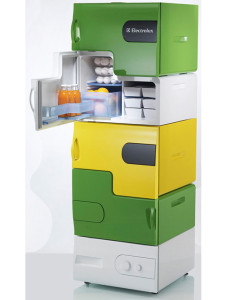
Modern-looking space savers for your food - (Image Credit: Electrolux)
3. Electrolux Flatshare Fridge – Fridge space can quickly diminish for people that live in a shared living situation. Electrolux, designer of functional and practical appliances recently debuted their stackable mini-fridges called Flatshare Fridge. These self-contained modules are placed on a base that then operate as mini fridges that can be stacked as a single unit going all the way up to five units. We especially love how you can personalize each fridge with its own distinctive patterns and look – creating your very own unique module to compliment your style and home. Currently still in development, we are all hoping this one hits the market soon.
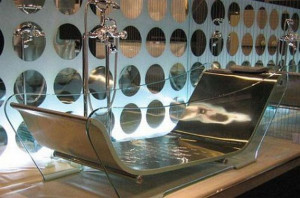
A glass tub for the ultimate in relaxation - (Image Credit: Wasauna)
4. Wasauna Glass Bathtub – While clear showers have been around for while, this is the first time we are seeing glass bathtubs. Created by Wasauna, the luxurious bath tub has a dimpled anti-slip design whose unit is surrounded by glass while the base is covered in stainless steel. The tub is also equipped with an adjustable and padded headrest for maximum comfort that is currently on “sale” for $3,200.

A teapot with a sleek edge - (Image Credit: Sorapot)
5. Joey Roth Sorapot – You would never imagine that this sleek and modern-looking apparatus was a teapot; however, at a closer glance you will see a sustainable teapot designed for both aesthetic appeal and function. Created by designer Joey Roth, the Sorapot, made from stainless steel, borosilicate (heat-resistant) glass and silicone can make two cups of tea in its clear modular tube unit that allows tea leaves to unfurl, naturally. The Sorapot is also designed to change depending on how it is cleaned as well as how it is held that will eventually matte. At $200 per pot, you will have to be quite the tea-lover to invest in this new product.
Don’t forget to like us on Facebook and follow us on Twitter!
• Follow us on Twitter @Relocation_News
• Become a fan of Relocation.com on Facebook

A few small changes can really enhance your home - Image Credit: http://www.outinhome.com/
By Faith Teel
Special to Relocation.com
The second day of January often brings a sense of relief: you’ve gotten all of your vacationing out of your system, and now you’re ready to roll up your sleeves and dive back into your daily life.
The first weeks of a new year are also a great time to spruce up your house. After all, you’re already taking down the Christmas decorations, so you might as well redecorate a little bit while you’re at it. Here are a few suggestions to get you started.
Get crafty. Are you snowed in with nothing to do? Why not get out those crafty projects you’ve been meaning to tackle? This is a great time of year to repaint an old lamp, make a collage for your bedroom wall or sew a new pair of curtains. Start the year with a little bit of artistic inspiration, and set a trend for the rest of the year.
Bring the outdoors in. Sometimes winter can make a house feel drab and glum. If you’re really longing for spring, stop by your local nursery or florist and pick up a few forced bulbs. You can also perk up your home by taking a cue from the Japanese, who change the artwork on their walls in response to the seasons around them. This winter, why not pick up an inexpensive poster that reminds you of warmth and sunshine?
Do a thorough housecleaning. A chilly day is ideal for cleaning your home from top-to-bottom, because household chores give you a little exercise without actually forcing you to go outside. Now is the time to dust the chandelier, clean the lint out of the laundry room, shake the breadcrumbs out of the toaster and re-fold all of the sheets in the linen closet.
Update your light bulbs. Especially if you have high ceilings that put your light fixtures out of reach, it’s easy to put off changing your light bulbs. You need all of the bright light that you can get in winter, so make sure that all of the bulbs in your house are working. While you’re at it, dust off any glass shades, and give the fabric ones a good scrub in the sink (or at least spot-clean them).
Get ready for spring. Speaking of warmth and sunshine, winter won’t last forever. Now is the time to plan next year’s garden. Even a small apartment balcony has room for a few planters. Use them as an excuse to page through gardening catalogs and dream of summer flowers.
Give to charity. This winter, take a few minutes to sort through your stack of canned goods and other dry food. Food pantries often get lots of donations before Christmas, only to fall short later in the season. Why not give those dusty tins to someone who will appreciate them?
Don’t forget your clothes closets. This is a great time of year to sort through your bedroom closets and get rid of any summer clothes that you’ll never wear again. (Hint: if you didn’t wear it last summer, you probably don’t need it.)
Patch it up. Need a little coziness on a cold afternoon? Try an old-fashioned remedy: mend your clothes and other household items. This is a great time to sit in a comfortable chair in the warmest part of the house and sew patches onto old bed sheets or fix a tear in your favorite skirt. A cup of tea and an audio book can round out the picture and turn an otherwise dull chore into a pleasant refuge from your worries.
Paint the town—or just the house. If you manage to catch a few days of winter thaw so that you can open your windows for ventilation, now is a great time to repaint your walls. Pale, warm colors are an excellent choice in winter, because they reflect more of that scarce sunlight. Even if you can’t get a warm enough day to repaint a whole room, get out your cans of touch-up paint and freshen up the spots where the kids have been leaving hand prints.
Having a home that’s bright and clean is a great way to beat the winter blues. As you while away the days until spring, get ready for the new year by cleaning house and freshening up your surroundings. It will keep you feeling energized and uplifted all season long.
Don’t forget to like us on Facebook and follow us on Twitter!
• Follow us on Twitter @Relocation_News
• Become a fan of Relocation.com on Facebook
December 31st, 2010 by
Admin
Categories:
design and decorate,
Do It Yourself,
exterior projects,
Holidays,
Home Improvement,
interior projects,
Moving,
Moving Day,
Moving Industry,
Storage Comments:
No Comments » 
Happy 2011! (Image Credit: AL.com)
By Serena Norr
It’s that time of year again; out with the old and in with the new. Part of that old might involve upgrading your home with a renovation or new design or throwing out your old clothes or moving to a new town or city – all exciting prospects that warrant a few pointers in the new year. As we say goodbye to 2010, we wish you the best of luck with your prospective change and have a few pointers to help you make your 2011 brighter, more exciting and more organized! Happy New Year from all of us at Relocation.com!
1. Moving in the New Year? Whether you are planning a big move across the country or a small move around the block, we advise planning ahead. All too often we hear stories of people scrambling for movers – only to use the first company that they find. We always advise researching three to five licensed moving companies from a reputable resource such as Relocation.com AND to have the movers come to your home for an in-house moving estimate. Taking estimates over the phone is a huge NO for 2011 – these prices are not binding and are subject to increase on moving day. Having movers come to your home allows them to see your belongings (thus determine the price) and this is also a great opportunity to ‘interview’ them – where you can ask them about anything from their insurance policy to how long they have been in the industry. No questions are off limits.
2. Decorating? Designing? Renovating? If you staying put you may want to spruce up your home with an exciting decorating project or an entire home renovation. No small feat, you should start by determine if the project is a necessity (leaky faucets) or a want (painting a room). The necessity should take precedence over the want and in some instances should only be handled by a professional. Be honest with yourself by what you can handle. You don’t want to start a huge project only to find out that you made a bigger mess that you started out with. As with finding a mover, meet with three to five contractors, architects or home improvement experts to discuss your project. They can also tell you how long they are expected to work in your home, what fees are involved and what the room will look after the project (if you designing). If it is a simple project, like painting, create a plan for yourself. Make a note of your budget, prospective color scheme and the estimated time line. Visit your local hardware store and bring home a few samples before you begin the job – also make sure to ask about what supplies you will need.
3. Out with the old in with the new. The New Year is a great time to get rid of some junk that you have been hoarding. Oftentimes we hold on to items that we no longer need or no longer realize that we even have. This turns into junk; leaving our homes filled with tons of useless stuff. Of course, some items are valuable or sentimental to us but still may not have a place in our homes. In those instances, consider keeping your belongings in a secure and climate-controlled storage facility. Going from room-to-room, evaluate your stuff by placing your items in a keep, toss or donate/store pile. Be honest with yourself about your needs vs. wants as well as your space restrictions. Items in the keep pile are necessities. Items in the toss and donate pile can be sold in a garage sale or donated to a local charity or to the Salvation Army.
4. Storage solutions. We are huge fans of storage – as mentioned above. This doesn’t only include housing your belongings in a self storage facility but placing your items in smaller organizational units to clear up some space. We love under-the-bed storage options such as this one from Bed Bath and Beyond and this modular closet system that organizes items in your closet. The kitchen and the bathroom are also major areas for clutter. Consider using roll-out under-cabinet drawers to contain and organize anything from products to dish towels.
Stick with your housing or moving resolution for 2011 – big or small – Relocation.com is here to help you every step of the way!
More Ideas for the New Year:
Don’t forget to like us on Facebook and follow us on Twitter!
• Follow us on Twitter @Relocation_News
• Become a fan of Relocation.com on Facebook

It's beginning to look a lot like Christmas. How to decorate your home this holiday season.
(Image Credit: http://www.christmaslightsetc.com/)
By Faith Teel
Special to Relocation.com
This year has been a tough year on many budgets, but that doesn’t mean you have to hold back on the Christmas decorations. Instead, plan wisely, search for bargains, use what you what you have and create your own decoration as well. This holiday is about joy, not money. In this article, we’ll give you lots of tips for making or finding inexpensive Christmas decorations that sparkle with good cheer despite their humble origins.
Christmas for Kids
If you have children at home, now is a great time to fall back on traditional favorites. Keep in mind that we’re not the first generation to have Christmas on a budget; our parents and grandparents all knew how to “deck the halls” with things they already had at home.
Salt Dough Ornaments – Salt dough are like cookie dough, except that it doesn’t spoil and it’s inedible. It’s typically made of just salt, dough and flour, and any old-fashioned cookbook (or new-fangled recipe website) will have a salt dough recipe. Your kids can use salt dough to make decorative “cookies,” bake them, and then paint them with craft paint. Be sure to add holes for ribbon so that they can be hung on the Christmas tree!
Paper Chains – Paper chains are simple loops of paper combined to make a long garland that can be wrapped around your Christmas tree. They’re easy to make with a stapler or a pot of glue. Use ordinary construction paper, or up the ante with gorgeous wrapping paper or scrap-booking paper. (Children really appreciate good paper.)
Snowflakes – Every kid has cut dozens of snowflakes made from paper folded into six or eight sections. This year, jazz them up by using golden or silver paper, or try using colored paper in several layers so that the holes in one snowflake show the colors of the one behind it.
Popcorn Strings – One of the old-fashioned traditions that we’d like to see a return to is the string of popcorn on the tree. Use air-popped kernels for a long-lasting garland that doesn’t smell like butter.
A Sophisticated Christmas
Kids’ decorations are cute, but sometimes the Martha Stewart in your heart calls you to decorate with a more grown-up, sophisticated palette. Luckily, Christmas ornaments don’t have to be expensive in order to look expensive.
Paper Ribbons – This is the grown-up version of the kids’ paper chain. Get some lovely parchment paper or some elegant wrapping paper. Cut the paper into one-inch-wide strips and glue them end-to-end to make a long “ribbon.” In your best handwriting, use a magic marker to write the words of a favorite carol or poem on one side of the paper ribbon. Wrap your ribbon around your Christmas tree or hang it over a doorway.
Presents on a String – Save your tiny boxes throughout the year and wrap them in elegant paper. Run a string through them using a big darning needle, and then hang them in your house as a garland. Use bigger boxes as decorations on a fireplace mantle or a hall table.
Glittery Branches – Two of our best friends in budget decorating come together in this craft. Check your yard for shapely dead branches, and then spray them with metallic spray paint for a lovely winter sculpture. Hang Christmas ornaments from the glittery twigs.
Bring the Outdoors In – This is a great time to trim back that holly that’s been overwhelming your sidewalk. Look for pinecones and evergreen branches, too. We’ve even scored a branch of mistletoe when the landscapers were trimming it out of the trees at our local park.
Heavily Ornamented – Do you have more Christmas ornaments than you can fit on your tree? Why not hang them everywhere else, too? Chandeliers are prime candidates for Christmas ornaments, and so are doorways. Do you have a spare tree topper such as an angel or a star? Try topping the end of a stair banister or the finials of a bedpost.
Apples and Oranges – Another of our favorite decorating tips is to use tomorrow’s food for today’s decorating. Apples and oranges are lovely when heaped in a basket with a few pinecones and a red velvet bow. If you have a cupcake stand, replace the cupcakes with fruit to make an apple “tree.”
Dessert – Fruit isn’t the only decorative food. To quote that classic cookbook, “The Joy of Cooking,” “desserts give a hostess a chance to build a focal point.” An elegant cake can make a gorgeous centerpiece for any dinner party. If you’re not an expert at frosting, cut a paper “snowflake” and lay it over a dark cake (such as ginger or chocolate). Sprinkle the cake with confectioner’s sugar and then carefully remove the paper. The paper will leave a pattern in the sugar.
No matter how slim your budget is, you can always find a way to make a cheerful Christmas. Just stick to the old-fashioned essentials, and remember: it’s not about how much money is in your wallet; it’s about how much love is in your heart.
Don’t forget to like us on Facebook and follow us on Twitter!
• Follow us on Twitter @Relocation_News
• Become a fan of Relocation.com on Facebook

A family celebrating the Festival of Lights
By Serena Norr
The holiday season is finally here and for many of us that means shuffling through stores in search of the latest and greatest toy or gadget, but we all know that this is not the true meaning of the holidays. Part of that includes staying focused on what is really important – spending time with family and friends including enjoying traditional fare, customs and music and simply being together. Starting with Hanukkah (or Chanukah), Relocation.com has the best ways for you and your family to celebrate this eight-day holiday known as the Festival of Lights.
Make Hanukkah cards. Cards are a great way to pass along well wishes to friends and family members and what better way to spread the message but by making a homemade card. Use old wrapping paper or images from old magazines or websites like Craft Creations, cut out the images and glue them on a piece of construction paper with a sealant like Mod Podge. Your children can also draw a picture on the front or you can glue on a family picture. Write your holiday greeting inside the card and include a small wallet-size picture of your family.
Make food together. Food is one of the central elements of Hanukkah and getting children involved is a great way to teach them about its preparation and traditional significance. Kids can help shred potatoes and onions for the latkes or prepare batter for jelly donuts. They can also help cut out cookie shapes or dress them with blue and white sprinkles. Other food items that they can help with: applesauce, cutting up carrots for pot roast or matzo ball soup or opening packages of noodles for noodle kugel.
Listen to music together. Play Hanukkah music at home throughout the eight days. Some traditional favorites include “Chanukah: Festival of Lights,” ” Spirit of the Holidays, O’ Hanukkah” or a modern classic like Adam Sandler’s “The Hanukkah Song.”
Arts and crafts. Aside from making Hanukkah holiday cards, children can create their own candles or menorahs. Candles are made from beeswax and menorahs can be made out of sculpting clay, which most craft stores have. Kids can decorate their menorahs using paint or markers to create their own personal and unique symbol of the holiday. You can also create a Hanukah scrapbook or collage using images that relate to the holiday and pictures of your family.
Read books. Books that discuss the theme of Hanukkah are great to enjoy over the holiday as well as teach lessons in a fun way. “Light the Lights,” “Latkes and Applesauce,” “Light the Candles: A Hanukkah Lift-the-Flap Book,” and “The Borrowed Hanukkah Latkes” are great book younger children. Older children might like “Moishe’s Miracle: A Hanukkah Story” or “No Such Thing as a Chanukah Bush, Sandy Goldstein.”
Consider a video. Kids also love videos and they can be an entertaining way to teach them about the values and principals of this holiday. Check out “A Rugrats Chanukah,” Chanuka at Bubbe’s” or “A Taste of Chanukah.”
Light the lights. Of course one of the well-know traditions of the holiday involves lighting of the menorah. Gather the whole family together and reveal in the beauty of the menorah, and perhaps your homemade creations. Traditionally, the menorah is placed in a front window in order to share the light with neighbors.
Play games. Games like dreidel, a spinning top, are traditional favorites during Hanukkah. The Player use candies or chocolate coins called gelt to play the game. When a player spins the dreidel, he or she will either take some treats from the pot, or put some into the pot.
Share gifts. Another part of the holiday includes eight days of gifts. Exchange gifts together and enjoy the act of giving to the people that matter the most to you.
Remember, holidays and traditions are best when they can be shared with others. Have a Happy Hanukkah!

Have too many clothes? Swap them or give them away before you move.
By Serena Norr
Now that you are moving you can actually see how much stuff you own; and most likely, it’s a lot of items that you didn’t even realize that you had. The beauty of moving is that you not only get a chance to start fresh – whether that be for a new job or the desire to explore a new town – but you also can get rid of extra baggage in the form of your old belongings. One way to get rid of your items is to have a swap party. This is a great way to have an intimate and free clothing exchange. Add some food and drinks and you have a free going away party – as your old clothes find a new home. Party down this weekend with Relocation.com’s clothing swap party guide.
1. Gather your stuff. Before the party can happen, you’ll have to organize your items into piles of what you want and don’t want. As part of your packing plan, consider what items are of value but those that you no longer have use for. This might include an expensive jacket that you no longer wear or old worn in jeans. Devise these items into a pile for your party. If you have time, wash and fold these items beforehand.
2. Organize a size box or items by type. During the moving process, organization is the name of the game. Place your items size into various boxes – this will also make it easier for your guests to know where to place their clothes. If you are swapping other items, consider organizing them by type – so books would go with books, DVDs with DVDs, etc.
3. Send out the invite. Now that you know what items you want to get rid of (er, swap), it’s time to send out the invitation. You will know how many invites to send out based on the size of your home – or wherever you may be having it. Send out a mass email or an Evite to organize your guest list. In your invite, you can also ask your friends to contribute to the swap by bringing a food item or drink – no one wants to swap on an empty stomach.
4. Get the list together. Now that you know who is coming, set up your list and do a little shopping. Since you have assigned your friends to bring some food and drink items, your shopping should be minimal. Consider some basics like hummus and pita bread, carrots, chips, wine or beer, water and fruit.
5. Party time, excellent. It’s almost time to partay! Before your guests arrive, arrange all of your clothes into their appropriate size box (small, medium and large) and set up your food and drinks. As your guests arrive, explain your organization system and start swapping!
With any luck, your old clothes, knickknacks and books will have found a new home – clearing up some space making it easier (and lighter) for you on moving day. Taking something is also not a big deal – but be sure to choose wisely. You don’t want to end up with more items than you had before the swap!
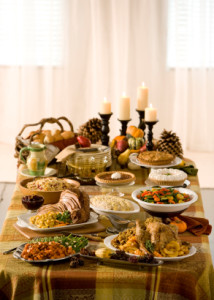
Dress Up Your Table This Thanksgiving.
By Faith Teel
Special to Relocation.com
Thanksgiving is a wonderful holiday that involves spending time with family and loved ones – not to mention a bountiful amount of delicious food that will have you stuffed for days. This is also one of the easiest holidays to decorate for since most of the key focus is on the food and less so on overly done decorations. With that being said, the only rule to keep in mind is that this holiday revolves around the dinner table. As long as you decorate with that in mind, you can have amazing decor on a small budget.
Help Guests Work Up an Appetite.
The easiest way to decorate any room is to pick a few bold colors, combine them with neutrals and stick to your chosen palette. Since Thanksgiving is all about food, you may want to stick with “appetizing colors,” which is how color experts refer to certain colors stimulate the appetite. These include many of the same colors that you see traditional holiday food: golden yellow, apple red, pumpkin orange, plum, brown, cream and sage green.
Inspiration from Nature.
Thanksgiving is also about the bounty of the autumn season, so a good place to get inexpensive (and elegant) decorations is the great outdoors. If you’re fortunate enough to have a garden, or if you live near a park, forest or other pleasant outdoor place, take a walk. As you stroll along, keep an eye out for natural materials that would look great on your table or in a big vase. For example, if you grew asparagus in your garden this year, pick a few of the dried, feathery ferns with their red berries still attached. Other great natural materials include pine cones, brightly-colored leaves, evergreen branches, holly, seed pods and feathery grasses. (Just make sure that if you’re picking plants from someone else’s land, you have the owner’s permission.)
Go Shopping.
If you live in the heart of the Big City and a nature walk is out of the question, drop by your local farmer’s market or grocery store instead. Food can be wonderful for decorating, and if you can eat your decor later, your grocery budget can double as your decorating budget. Pumpkins and squashes look wonderful in baskets, and if stored properly, they can keep until it’s time to bake them for Christmas dinner. Apples, oranges, lemons and pineapples, in a simple clear bowl, also make lovely displays and keep well.
Around the House.
The cheapest kinds of decorations are the ones that you already have. The first place to raid is your box of Christmas ornaments. This isn’t the time for snowmen and angels, but how about those red apple ornaments, or the ones shaped like birds, or the sparkly pears? Wouldn’t they look great hung from a chandelier?
I Want to Paint It Black (or Gold).
Keep an eye out for anything that can benefit from a coat of paint. Glittery gold or copper spray paint are excellent choices to shine up an old candlesticks or napkin rings.
For the Table:
Food, Glorious Food.
Of course, the centerpiece of any Thanksgiving holiday is the table. In fact, because the holiday is all about food, why not use the meal as the decoration, too? Make a pretty cake ahead of time and set it in the center of the table. (A covered cake plate can be useful to keep small fingers out of the icing.) Or tempt your guests’ appetites early by heaping chocolates or other pretty finger food in a tiered serving plate.
Bust Out the Good China.
Thanksgiving is a great time to get out the good china. If you’ve never been a fan of fine porcelain, you can still use your plainest everyday ware and dress it up with accessories such as cloth napkins and pretty goblets.
On the other hand, it’s tempting to hand out paper plates at big holidays like this, unless you can persuade someone else to wash the dishes. If you use disposable plates, there are still several ways to keep it classy. First, be sure to use sturdy plates that won’t let the gravy soak through. Solid colors will be more elegant than patterns. If you have a little bit of room in your budget, spring for classier disposables made from bamboo or clear plastic.
If you use disposable plates, try to use your best serving bowls. Even potato chips look better in a crystal dish!
A Little Bit of Fun:
Giving Thanks.
Because Thanksgiving is a family holiday, it’s a great time to involve your children in the decorating. Save your brown paper bags from the grocery store and help each child cut out a few leaf shapes. (You can also use colored construction paper.) Have them write something they’re thankful for, and then string the leaves together with a needle and thread. Hand your “Chain of Thankfulness” over a doorway or from a chandelier.
Old-School Decor.
Old-fashioned paper chains made from paper in pretty colors are another fun project. Update the idea by using pretty wrapping paper in brown and red and gold. (Kids really appreciate the chance to use nice paper.) You can also have the children use a needle and thread to string together plain popcorn.
For the Little Ones.
If you plan to seat the children at a separate table, consider adding a few fun features to keep them occupied while Mom and Dad eat. For example, you can cover the table with plain white butcher paper and put a basket of crayons (or washable markers) in the middle. You can even go a step further and add Thanksgiving-themed coloring books.
Family Fun.
The fun can continue into the evening with a “bobbing for apples” contest. To avoid the mess of a tub of water, hang apples from the ceiling by a long string. Have participants try to catch the apple in their teeth.
Sign Here.
Crafts don’t have to be limited to kids. This year, make a light-hearted “guest book” by drawing a pear-shaped turkey body on a nice sheet of parchment paper. Have each guest add a thumbprint in the tail area, than sign their names nearby.
Thanksgiving is a time to celebrate the things that make life sweet: a loving family and close friends. If you decorate with them in mind, you don’t need a big budget to have a welcoming home. Remember, a little creativity and using what you have goes a long way.
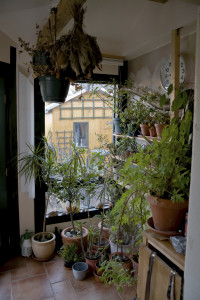
A few indoor plants can really brighten up your home
By Vance Stevens
Special to Relocation.com
While commercial settings typically offer an atmosphere of large, indoor plants, they don’t have to be limited to dentists’ offices and malls. In fact, indoor plants add beauty and function to any indoor space and can be a perfect addition to brighten up your home during those chilly winter months. Green plants also help filter the air, creating a healthier environment for work or play. And with a few strategically placed indoor plants, you can transform an ordinary space into a stress-free zone. Here are a few indoor plants that will help you brighten up your favorite room.
Palm – Coming in a wide variety of sizes and leaf shapes, palms range from just a few feet to over 20-feet tall. A few of the most popular pines are the Sentry and Bamboo palms, which can reach an average height of 9 to 10 feet, and the Areca and Chinese Fan palms, which average 5 to 6 feet in height. There are many different type palms to will meet your style needs.
Chinese Evergreen – The Chinese evergreen is an excellent selection for indoor gardening and decoration. With its low lighting needs and low maintenance, the plant is an aesthetic addition as well as a healthy one that is listed as a natural indoor air purifier.
Norfolk Island Pine – If you are looking to add a touch of the tropics indoors, Norfolk Island pines can reach a height of more than 10-feet and bring with them a rich aroma of the great outdoors. The plant’s resemblance to another type pine has made it a popular holiday decoration. Norfolks can survive in only household incandescent or fluorescent lighting if they receive a minimum of 16 hours of light each day.
Chrysanthemums – Chrysanthemums are resilient, colorful flowers that are grown indoors in any climate and outdoors. The plant is easy to care for and thrives with given exposure to at least a half-day of sunlight, moist soil and room to breathe. Chrysanthemums come in a wide variety of shapes and colors.
Ficus – There are several types of Ficus (also known as figs), and a large majority of them come well-suited for the role of large, indoor plant. Ficus Alii, (a type of Ficus characterized by deep green, long, narrow leaves) rubber plants and fiddle leaf figs are some of the most popular, and grow from 4 to 12 feet tall. The Ficus requires daily sunlight, ample humidity and water every 1-2 days.
Spider Plant – Spider plants are fast-growing, attractive perennials that feature slim, elegant leaves and small white flowers. A plant able to tolerate low-light conditions well, the spider plants can grow in the shade if given continually moist soil. If left in extended dry conditions, the tips of the long leaves will turn brown until water resumes. The spider plant is also excellent for filtering airborne toxins.
Wandering Jew – The wandering jew is a popular indoor plant that good for cleaning the air in the room. It is often grown in a hanging basket due to its sprawling tendencies. The plant’s 3-inch-long leaves are charmingly spotted and covered with a fine layer of soft fuzz. Place the plant in rich, loose soil in a dimly lit spot; remember to keep the soil moist for optimal growth.
Succulent/Cactus – There are several types of succulents and cacti that make impressive large, indoor plants. Milk Stripe euphorbia often exceed four feet in height and are nearly as wide. There are a number of tall, upright cactuses perfect for the indoors, such as Snowball, Silver Torch and the Column cactus.
If you have any questions, comments or inquires, please contact me at editorial@relocation.com.
By Serena Norr
It’s a spooky edition of The Celebrity Beat. These famous haunted houses will thrill and shock you with their ghastly tales. Don’t be too scared, after all these are just homes, right?

The Amityville House - (Photo Credit: Zillow.com)
1. The Amityville Horror House
Location: 108 Ocean Avenue, Amityville, New York
This haunted abode inspired by a book of the same name and five movies is often considered one of the scariest houses in America. Though we can’t say if it is haunted or not, the home located in Amityville, New York, was the scene of the horrific murder where Ronald DeFeo Jr. shot his parents and four siblings in 1974. Later sold to the Lutz family in 1975 who left after only living in the house for 28 days citing that they saw “slime oozing down walls, furniture moving, swarms of flies in the dead of winter and slamming doors,” as stated on Zillow.com. It was recently sold again (after only being on the market for 70 days!) for $1.15 million to a retired couple who states that the scariest thing about the house is the onlookers that visit it.

The Haunting in Connecticut House - (Photo Credit: AP Photo/Jessica Hill)
2. The Haunting in Connecticut House
Location: 208 Meriden Ave, Southington, Connecticut
Dubbed the Amityville of Connecticut, this former funeral parlor, located in Southington, was converted into multiple family apartments in the 1980s. In 1986, a New York family called the Snedeker’s moved into the house and began seeing demons — “one with high cheekbones, long black hair and pitch black eyes and another that wore a pinstriped tuxedo whose feet were constantly in motion,” according to the Daily Beast. The family also reportedly noticed foul smells, heard unexplained noises and personality changes in their eldest son, Philip, who started dressing and talking differently. The Snedeker’s later recruited Ed and Lorraine Warren (also involved in researching the Amityville). They reportedly had an exorcism that cleared the home of its ghosts in 1988. This story was later adapted into a movie in 2009 called The Haunting in Connecticut.

The Kresiher Mansion - (Photo Credit: http://prodigalborough.com)
3. The Kreischer Mansion
Location: 4500 Arthur Kill Road, Staten Island, New York
A prolific brick-supplier in the 1800s, the Kreischer family built two Victorian-style homes in Staten Island for the family- one home for the parents and the second, located on a secluded hilltop, was for their son. Shortly after the second home was built, the son, Edward Kreischer, shot himself and the house later mysteriously buried down. It is believed that the home is haunted by the son and his wife where guests have heard noises and doors banging. In 1996, the home was converted into a restaurant where guests and workers heard noises and doors slamming.

The Franklin Castle - (Photo Credit: www.prairieghosts.com)
4. The Franklin Castle
Location: 4308 Franklin Boulevard, Cleveland, Ohio
Considered the most haunted house in Ohio, the Franklin Castle, the home was built in 1865 by Hannes Tiedemann for his family. Over three years in the house, three of Tiedemann’s children died as well as well as his mother. Since his wife, Luise, was haunted by the family tragedies Tiedemann decided to expand the home to take her mind of the strange deaths. The additions included secret passageways, secret rooms, and hidden doors. Following Tiedemann’s death in 1908, it was reported that these secret rooms were not only a clever construction project. Here, he reportedly killed his niece by hanging her and is believed to have murdered a young servant girl. Additionally, a future homeowner found dozens of human baby skeletons in some of the secret rooms. Those that have lived or stayed in the home reported that they have heard strange sounds in the home like a women chocking, babies crying, organ music and footsteps. Currently, the home is dormant but it is reportedly being converted into a tourist attraction.

The mysterious Bell Witch Cabin - (Photo Credit: www.bellwitch.org)
5. Bell Witch House
Location: Adams, Tennessee
It is reported that the Bell family resided in this home in the early 1800s and started to hear strange noises. The youngest daughter, Betsy, also began to feel a gnawing like an invisible rat and the parents said they started having their blankets pulled over their heads. The Bell children also woke up with bruises on their face when the father decided to seek help. The community soon learned about the haunting and wanted to talk to the “witch” where it was reported that something from the house spoke in a husky whisper who said she was Kate Batts. As the years went on the Bell family continued to live at the house – where the witch apparently continuously beat and caused havoc to the Bell’s. Charles Bell, one of the brothers, even wrote a record of the haunting called in 1935 The Bell Witch: A Mysterious Spirit, or Our Family Troubles.
If you have any questions, comments or inquires, please contact me at editorial@relocation.com.
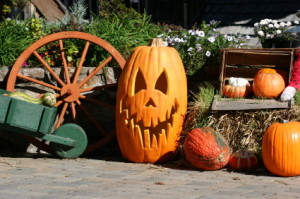
Showcase your pumpkin carving and decorating skills this Halloween.
By Faith Teel
Special to Relocation.com
Halloween isn’t just a time for people to dress up… houses like costumes, too! This year, why not try a few spooky decorating ideas that will scare your friends and flex your crafty muscles, without putting too many holes in your pocketbook.
Pumpkin Alternatives
Carved pumpkins are the classic Halloween decoration, but who has the time and really, who wants to clean up that mess? Luckily, there are lots of easy alternatives that won’t require you to threaten an innocent pumpkin with a huge, serial-killer-style knife.
Painted Pumpkins – All you need is a little bit of black paint to make silly or spooky faces… or get a can of glittery spray paint and paint the whole pumpkin to make the ultimate statement in Halloween glam. This is great for small kids, too, who can use as much paint or as little as possible and go wild with their Halloween pumpkin.
Squash – Next time you’re in the supermarket, look for a few pumpkin alternatives. Painted butternut squashes make fantastic ghosts and goblins… and if you keep them in a cool, dry place, they could last until it’s time to make squash casserole for Thanksgiving.
Lumpkins – Many supermarkets offer pumpkins and squashes that are so strange that they don’t need carving. Look for “peanut pumpkins,” which are covered in funny “warts” resembling peanut hulls.
Balloons – Your local card store, gift shop or florist probably sells helium balloons. Skip the pricey, shiny Mylar balloons and opt for inexpensive orange, white or green rubber balloons instead. Take them home and draw faces on them: jack-o-lantern faces for the orange ones, mummies or ghosts for the white ones and witches for the green ones.
Scarecrows – Creating a crafty scarecrow is a great way to showcase your decor skills, while also enhancing your front lawn.
Subtle Scares
One of the best kinds of Halloween decorations are the subtle ones that take a minute to notice, but really creep your friends out when they finally see them.
Things Under Glass – Save your old spaghetti jars, wash them out and remove the labels. Now fill them with mysterious-looking things and add a stick-on label with a scary name on it. For example, you could put an old rubber mask in a large jar and label it “Granny’s Pickled Heads.” Or try spiny chestnuts labeled “Poison Urchins” or dried leaves labeled “Deadly Nightshade.”
Are You Going to Eat That? – Try the same trick with jars still full of food. Tomato pesto, black olives and pickled garlic take on new meanings when labeled “Frog Hearts,” “Eye of Newt” and “Werewolf Teeth.”
Apple Crones – Peel a few apples and carve them to look like an old woman, with slits for eyes, a big nose, and a straight line for a mouth. Let the apples wither for a few days, and soon you’ll have a row of little witch faces.
Weird Family Photos – Scour the internet for old film stills of Dracula, the Mummy or Frankenstein. (Try to get high-resolution pictures.) Print them out in black and white and slip them in with other family photos. You can even make a game out of this where the first person to notice will receive a Halloween treat.
Mysterious Bloodstains – Fake blood aren’t just for costumes anymore. Squirt it on old pillowcase and then pull the pillowcase over a throw pillow. Put it on your couch for a scary touch. Just be sure to use fabric that you don’t mind putting a few stains onto!
Graveyard Trees – Now that your container garden is dying back, why not pull out a few dead annual plants and replace them with bare branches stuck into the soil like trees? You can use them as-is or drape them with cobwebs and plastic spiders.
Big Statements
Subtle can be fun, but if you’re hosting a party, you’ll want to make big changes that affect the whole atmosphere of your home. Here are a few ways to make the whole room look delightfully spooky.
Orange or Red Christmas Lights – Now is a good time to raid your bucket of Christmas lights. Orange, red or white lights all make great lighting for haunted Halloween homes.
Paint It Black – Need to make a major statement? Raid your attic, closet, garage or local yard sale for anything that you can spray paint black. Old chandeliers are great for this, and so are candlesticks and artificial flowers.
Black Bed Sheets – Are you planning to buy more bed linens soon? Why not get black or red bed sheets? They can double as quick covers for chairs and small sofas whose floral prints or bright colors might otherwise distract from your scary décor.
Cheesecloth, Cheesecloth, Cheesecloth – Cheesecloth is another inexpensive alternative for covering large furniture. It has a white, ghostlike color and an open weave that makes it look like a shroud. It’s also good for covering a Halloween table, wrapping over a mop head for an improvised ghost, or bandaging over an old hat form to make a mummy head.
Silhouettes – Black paper is your friend! Your local craft store may offer it in sheets or even big rolls. Use it to make silhouettes of mice, bats and cats, or cut larger shapes such as witches, werewolves, vampires or ghouls. Don’t limit yourself to the wall; try putting them in your baseboards, climbing up your steps or peering out of the windows.
In the Bathroom – Why not write something scary on the mirror in red lipstick, or use your spooky silhouettes or fake blood to make a great effect behind a translucent shower curtain?
Invitations – For inexpensive (yet scary) invitations, pick up some parchment paper from the same craft store and use a scary font to make your invite. (Or try a handwriting font and make your invitations look like a letter from Dracula!) Seal them up with the stick-on red wax seals used for wedding invitations.
Food Centerpieces – Halloween food is another subject entirely, but we couldn’t resist mentioning a few of our favorites. For a great centerpiece on the food table, try a mysterious green punch labeled “Love Potion.” If you’ve got a little time on your hands, adapt the classic gingerbread house with black frosting, licorice, candy corn, pumpkin candies and gummy worms to make a “haunted house.”
There’s no holiday like Halloween to bring out your inner decorator. Give a few of these tips a try… you’re sure to have a screaming good time!
October 6th, 2010 by
Admin
Categories:
Celebrity Real Estate,
condos,
design and decorate,
Do It Yourself,
foreclosures,
Home Improvement,
homes for sale,
Insurance,
Mortgages,
Moving,
Moving Industry,
Packing,
Real Estate,
Relocation,
rentals Comments:
No Comments » By Serena Norr
We never know what to expect when we research the celebrity housing market for the Beat. This week we were excited to learn that Steve Jobs was finally given the go-head to start the demolition of the historic property he owns called the Jackling House. The demolition, which took six years to approve, will involve the construction of a smaller and more contemporary space — simplifying the home and tearing down its 30 rooms that will reportedly cost Jobs $8.45 million to complete. This week, we also discovered that Larry the Cable Guy’s home was placed on the market. Listed for $1.55 million and developed by the “Git-r-done” comedian, the Florida log-style home includes a “man cave” with a pool table, TV, mini-bar and bar signs as well as a pool and a spa. Acting couple, Naomi Watts and Liev Schreiber are also on the Beat this week. They placed their 4,410-square-foot Los Angeles home on the market that includes an on-site gym, a two-story guest house and six-bedrooms. We look forward to what next week brings…and the (unexpected) real estate news that follows.
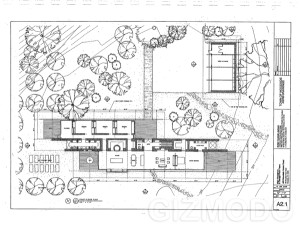
Floor plan of Steve Jobs' new home -Expected construction costs: $8.45 million. (Photo Credit: Gizmodo)
• Steve Jobs’ Construction Plans Revealed
Steve Jobs, the multi-billionaire and CEO of Apple finally received the go-ahead to renovate the historic Jackling House. The 17,000-square foot, 30-room Spanish Colonial home, built for copper baron Daniel Jackling, is owned by Jobs but he has been unable to complete or even start his plans for a full-on demolition and remodel. Architectural preservationists stated that the home was an historic piece of real estate and shouldn’t be demolished. Finally in July of 2010, the preservationists’ dropped their case but some elements of the house such as an organ, flag pole and decorative tiles are being removed and preserved. The newer and more contemporary home plans was reveled on Gizmodo – showing the elaborate floor plan created by Bohlin Cywinski Jackson – the design firm responsible for several Apple stores. The new floor plan indicates a smaller home – measuring at 4,190-square-feet – that will include five bedrooms and 3.5 bathrooms. The new design also indicates that there are plans to build a three-car garage, a pool with a pool house and a third building for an office. Additionally, among the six acres of land there are plans to add various plants and flowers, stone walkways and a private vegetable garden – a diminutively simpler home than the former grandiose estate. It is estimated that the home will be completed in 22 months.

Naomi Watts and Liev Schreiber's home - listed for $5,995,000. (Photo Credit: The Real Estalker)
• Naomi Watts and Liev Schreiber List Brentwood Home
Actor couple Naomi Watts and Liev Schreiber recently placed their Los Angeles home on the market for $5,995,000. The 4,410-square-foot, two-story home includes six bedrooms and 4.5 bathrooms; a two-story guest room; an on-site gym; a two-car garage and a gated and secured entry way. The European-inspired home also includes several fireplaces, an eat-in kitchen, formal dining room, a swimming pool and circular spa. The couple also owns a 2,900-square- foot condo in New York.
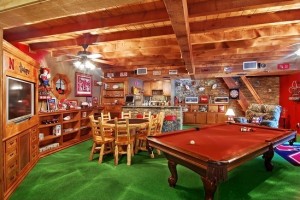
You, too, can have your own personal "man cave" if you buy Larry the Cable Guy's home - listed at $1.55 million. (Photo Credit: Housing Watch)
• Larry the Cable Guy Places Florida Home on the Market
Comedian Dan Whitney aka Larry the Cable Guy known for the catchphrase “Git-r-done” recently placed his Sanford, Florida home on the market for $1.55 million. The five-bedroom home, situated on 18.79 acres, includes a lot of interesting details that Whitney himself renovated. There is a “man cave” that includes a poker and pool table, mini-bar, TV and bar signs as well as an outdoor movie theater, a pool with a waterfall, an outdoor spa, detached gym and two children’s rooms with personal murals. Whitney sited outgrowing the home as the reason for the sale.
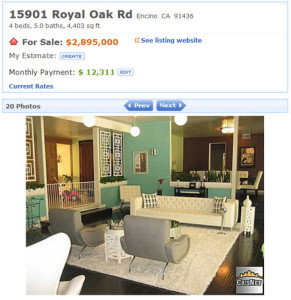
Scott Baio's home - sold for$2.5 million. (Photo Credit: Zillow.com)
• Scott Baio Sells Encino, California Home
Actor Scott Baio recently sold his “Spectacular Celebrity Owned Estate!” to an undisclosed buyer for $2.5 million. Built in 1964, the new buyer can look forward to enjoying 4,400-square-feet of living space, three fireplaces, four bedrooms and 4.5 bathrooms. The Encino, California home also includes a swimming pool with a hot tub, a tennis court, a koi pond, a formal living and dining room and a sprawling back yard with luscious greenery and gardens.

Have a garage sale this weekend! Trust us; it's easier than you think.
By Serena Norr
Maybe you’re in the process of moving and need to get rid of some junk or you’ve been living in your home for awhile and notice that you surrounded by stuff you never use. You know exactly what we mean: old knickknacks, clothes with tags on them and your old blender from the 1970s. Clearing up the junk in your life is one way to declutter your home; not to mention it will make you feel better. But before you drop off your stuff to your local Salvation Army or pass your items along to a friend, consider squeezing one last dollar (or two) out of them by having a garage sale. As the summer is winding down (sad, but true), garage sales are a great way to get rid of your unwanted baggage aka junk and make a small profit in the process. Here’s how to get organized and throw one this weekend.
1. What to Sell. Before you create the buzz about your garage sale, you will need to know exactly what you are selling. Going from room-to-room, make a list and collect the items you no longer need or want (most likely you know what these are). You can also make a list of items that you are thinking of selling but aren’t 100 percent sure of. If possible, pack the ‘to be sold’ items together in boxes or garbage bags for the big day.
2. Signage. If you have a sale, you will need to tell people about it. Word-of-mouth may work in small communities, but to really get the word out you will need signs. Enlist a crafty friend to help you create colorful posters stating the date, time and your address as well as alternative date should it rain (after all, Mother Nature can be a fickle one.) Don’t leave any of these details out – or people will not know where to go. Your sign should also list (briefly) what you will be selling such as books, antiques, baby clothes, etc. You don’t want to make the list too long, but if you have a rare or valuable item such as a 1950s Mickey Mouse doll or a slightly used Mac laptop definitely list them. Hot items like that are sure to draw in an excited crowd.
3. Post. You should post your sign one week before your sale. Any earlier and people will likely forget about it, not to mention your sign may be torn down. Post your signs everywhere in your neighborhood and think outside of the box. Ask your local coffee house, library, theater, grocery store or community garden if you can post your sign there. You may also want to place an ad in your local newspaper to get the word out.
4. Internet. The internet is yet another useful way to get the word out about your sale. Post the information from your sign on a local list serve or on Craiglist. Be careful about posting your address and phone number on Craigslist, though, but rather, write your email address so that interested parties can contact you directly.
5. Get Organized. Now that your neighbors are counting down the days to your sale; it’s time to solidify your list. If there are items that you are questioning such as sentimental items that you want to keep but is taking up space, then consider storage. Do one more assessment of your home and really try to get rid of your old stuff, consider them useful, but no longer useful to you. Two-three days before the sale, get all of the items together and start labeling. [We would advise labeling before a sale because many people are die-hard garage sale enthusiasts who will show up right when your sale begins (if not earlier).] This will also enable you to have your pricing figured out so that there is no uncertainty the day of. This is also helpful if someone is helping you with your sale – enabling you both to be on the same page and not making up prices throughout the day.
6. Check it Twice. The day before your sale, make sure everything that you want sold is packed away and that everything is labeled and ready to go. Also, make sure that you have your table ready and food for the day of your sale. Trust us, standing outside exchanging bucks will surely make you hungry.
7. Take Care of Yourself. Make sure to get enough rest the day before since you will likely be on your feet and outside for five or more hours. On the day of your sale have a hearty breakfast and begin setting up your items at least 30 minutes before the sale – like we said before, people will come early and they will be ready to shop.
8. Be Flexible. Try not to be too firm on your price (unless there is a reason) and be open to negotiating. Sometimes taking five bucks off your asking price will enable you to get rid of more stuff.
9. Enjoy Yourself! You worked hard to make this day happen, take it all in and be happy that your old items are now finding their way to a new home.
August 25th, 2010 by
Admin
Categories:
Celebrity Real Estate,
design and decorate,
Do It Yourself,
exterior projects,
foreclosures,
Home Improvement,
homes for sale,
interior projects,
Mortgages,
Moving,
Real Estate,
Relocation,
rentals Comments:
2 Comments »

Tyler Perry's new home - purchased for $7.6 million. (Photo Credit: Zillow.com)
By Serena Norr
The biggest home sale this week on the Beat – in both price and size – was the massive mansion purchased by Tyler Perry aka the man behind the sassy Madea. The mansion, called Dean Gardens, was created in the early 90s by software developer Larry Dean and his wife, Lynda, who certainly had their wild imagination come to life in this overly done 58-acre mansion. From a carousel-themed nursery to art deco-inspired bedrooms, the Deans personal taste is not for everyone, and some may even say that the home is more famous for the time it has been on the market. Listed on the market since 1993 (following the couples split), Perry plans to remodel and tear several rooms in order to create an environmentally-friendly home made out of concrete. To shift from extreme homes to an aesthetically pleasing one, Bradley Whitford and Jane Kaczmarek have placed their 6,769-square-foot Italian-inspired villa on the market. The couple, who also separated, is seeking $6.7 million for their six bath, six-bedroom home. Courtney Love’s public real estate plight has been reported on Curbed NY, the New York Post, and even here on Relocation.com. Searching for a home next to Anna Wintour proved unsuccessful (Love was rejected by the condo board) and we guess living in Soho’s posh Mercer Hotel had its days numbered as Love is now leasing Milla Jovovich’s townhouse (which has been on the market since 2008). We’re interested to see how that living arrangement plays out…From extreme homes to peaceful abodes, we have you covered on the Celebrity Beat.

Front door entryway at Tyler Perry's new home -- purchased for $7.6 million. (Photo Credit: Hooked on Houses)

Some themed-rooms at Dean Gardens -- now owned by Tyler Perry. (Photo Credit: The Real Estalker)
• Tyler Perry Buys Georgia Mansion for $7.6 Million
Entertainment maven (comedian/actor/director/producer/playwright), Tyler Perry recently purchased the massive Dean Gardens estate in the suburban outskirts of Georgia for $7.6 million. The 58-acre estate, located along the Chattahoochee River, has been on the market for 17 years (Michael Jackson was once an interested buyer), which was conceptualized by software developer Larry Dean and his wife, Lynda. The 32,000 square foot mansion was designed by the Dean’s 21-year-old that took four years to create a massive wonderland of themed-bedrooms and grandiose chandeliers. The Deans, though, never did enjoy their overactive mansion. Shortly after the construction of the home (in 1993) the couple separated and placed it on the market, which it has been on for 17 years. It was recently listed for $13,900,000 for the home and its furnishings (carousels, an entry way with massive-sized Italian paintings, custom murals and a room with Peacock décor were some features); however, Perry declined that offer and paid $7.6 million solely for the home. The home has been recognized (both praised and scoffed) for its unique décor options, formal gardens, outdoor band shell, 18-hole golf course, 12-car garage, 12 fireplaces, eight themed-bedrooms, nine bathrooms and on-site wedding chapel. We’re not sure what to make of some of these odd features and perhaps Perry wasn’t either as he plans to tear down the house and “… build one that is environmentally friendly and made of concrete,” according to Zillow.com. Zillow broke down even further, “this will include paying $25 million to build it, $18 million to pay for staff, taxes and utilities over the years and $1 million in annual maintenance.” Perry also owns homes in Los Angeles, an 11.4 acre home in Fairburn, Georgia and a mansion in Atlanta, Georgia. It sure pays to be a quadruple threat…

Jane Kacmarek and Bradley Whitford's villa - listed for $6.7 million. (Photo Credit: Luxist.com)
• Jane Kaczmarek, Bradley Whitford Place San Marino Villa on Market for $6.7 Million
Jane Kaczmarek and Bradley Whitford filed for a divorce in 2009, and sadly selling their gorgeous San Marino Villa was also involved in their separation. Located in San Marino (near Pasadena, California), the 6,769-square-foot home is described as an “Italian Renaissance Revival estate.” Designed in 1924, the home is situated on more than an acre of land that includes an outdoor swimming pool, original formal gardens, a spa, six bedrooms and six bathrooms, a library, hardwood flooring and a private guesthouse. The home, which underwent a massive renovation in 1997, was originally purchased for $5.9 million in 2004.

One of Emeril's kitchen's in his Manhattan Condo - Sold for $4.6 million. (Photo Credit: Wall Street Journal)
• Emeril Lagasse Sells Midtown Loft for $4.6 Million
Emeril Lagasse, famous for the catch phrases (“Bam” and “Lets Kick it Up a Notch), and of course for his Cajun cooking, recently sold his loft at the Beekman Regent NYC condo for $4.6 million. Located in Midtown Manhattan, the 4,000-square-foot apartment is a combination of two adjacent apartments that includes two kitchens – both of which have modern and stainless steel appliances, a formal dining room, a media room and two master suites. The apartment also features views of the skyline and the East River whose building’s interior includes 24-karat gold hardware and mahogany wood. According to the New York Post, Emeril won’t have to worry about his living situation that much longer since he reportedly just closed on a 6,900-square-foot Upper East Side townhouse. His new $11.5 million pad is recently renovated and includes two terraces, six fireplaces and a chef’s kitchen.
• Courtney Love to Lease Milla Jovovich’s NYC Townhouse
Much has been reported about adventurous tales of grunge rocker Courtney Love and her search for an apartment in NYC. Seems this tale has a happy ending, at least temporarily, as it was reported that Love is leasing a townhouse from actress/model Milla Jovovich. Love has been living in the luxurious Mercer Hotel in Soho for the past year while searching for a home in the West Village. Love has been looking to live next to Anna Wintour whose board rejected her request. Seems like a perfect situation for both parties as Jovovich has been trying to sell her Greenwich Village townhouse since 2008. Listed for sale at $7.5 million, the four-floor home includes four bedrooms, a private garden, a dining room and a rooftop deck. Curbed NY reported that Jovovich was seeking $24,000/month for rent. However, there was no word if this is what Love will be paying.

Weinberg's home for sale -- listed at $3,399,00. (Photo Credit: The Real Estalker).
• Max Weinberg Asking $3.3 Million for Flipped Home
Max Weinberg, resident drummer on the “Late Night with Conan O’Brien” and former member of Bruce Springsteen’s E Street Band recently listed a Hollywood Hills home for sale. Purchased in February 2009 for $2,888,000, Weinberg and his wife, Rebecca, renovated the home and is now looking to make a profit by listing it for $3,399,000. The contemporary five bedrooms, three bathroom home – previously owned by the parents of Maggie and Jake Gyllenhaal – includes views of the city, a swimming pool among a lush garden and angled stairs and 2,916-square-feet of living space. An infamous house flipper, Weinberg has been purchasing homes in California and New York, renovating them and selling them since the early 2000s.
Which home sparks your interest?

Now, that's what we call an urban garden!
By Kathy Woodard
Urban gardening can seem to be a paradox; how can one garden in a small space especially in places like NYC that are renowned for their cramped apartments? The fact is, it can be done and it is a fast growing trend amongst city dwellers. There are a few guidelines that can help get you started if you too are determined to grow your own piece of paradise, no matter how small your outdoor space.
Grow-in:
The fact is, for most city dwellers you are going to be doing your gardening in containers. The choices in containers are larger now than it’s ever been, including lightweight choices for those of us with balconies and rooftops. Many containers are made to look like expensive pottery or stone, but are in fact easy maintenance foam or other lightweight material. These pots are tough, beautiful and practical, and come in large sizes.
What you put inside the pot is important also. When growing on patios, terraces or balconies, it’s critical to make sure your pots are not too heavy. Using a soil less potting mixture will ensure you have healthy plants without the extra pounds. Many potting mixes even have time release fertilizer right in the mix, eliminating one more aspect of container gardening maintenance.
Grow-up:
When space is limited as it is in an urban garden, think up. Many plants can be grown in pots up trellises, tepees or poles. This is a great way to utilize your small space garden effectively to ensure you have room for a variety of plants. Think easy colorful vines, fresh pole beans, even roses!
Grow-down:
Growing down simply means using hanging pots to create space where there is none! Trailing plants are perfect for this, but shorter upright plants can be used in these designs as well.
What makes your garden grow?
An urban container garden in a small space needs the same things any garden does… water, nutrients and sunlight. Make sure you water regularly, as containers have a tendency to dry out quickly, especially during hot weather. Make sure each container has adequate drainage so the roots don’t sit in water and rot.
Nutrients get washed out of the soil in container plants quickly. Make sure there is a time released fertilizer in your potting soil, and every other watering consider adding a water soluble fertilizer to your watering can at half strength for an added boost.
You may be limited in the plants you can have in your garden if your outdoor space faces only one direction. Whether your small garden space gets mostly shade or mostly sun, or somewhere in between, there are great plants you can use. Be sure to stick to ones for your exposure. Planting a shade loving hosta in the blazing afternoon sun is never going to work. Likewise, expecting dwarf sunflowers to give you beautiful blooms with nothing but filtered shade is unrealistic.
Finally, while there is definitely a lot less weeding and maintenance with a container garden (one of the many percs!) make sure you take care of those things when they occur. Birds can drop weed seeds, flowers still need to be snipped off as they fade and occasionally you will want to replace plants that aren’t working.
Grow this!
Here are my top choices for plants to grow in your urban garden…
Edibles
- Pole and bush beans
- Herbs of all kinds
- Lettuce and other greens
Flowers
- Allysum
- Lobelia
- Geranium
- Sweet potato vine
- Purple fountain grass
- Verbena
Vines
- Pole vegetables
- Morning Glory
- Cardinal Flower
- Black eyed Susan Vine
No matter where you live, there is always a way to garden. Look for what you have, not what you don’t have. Grow, nurture and enjoy a garden in your small space!
Want free home and garden ideas? Kathy Woodard, is an author, columnist and home decorating expert. Visit her at her website www.TheBudgetDecorator.com and also at www.DecoratingYourSmallSpace.com.
August 11th, 2010 by
Admin
Categories:
Celebrity Real Estate,
design and decorate,
Do It Yourself,
exterior projects,
foreclosures,
Home Improvement,
homes for sale,
Insurance,
interior projects,
Mortgages,
Moving,
Plan Your Relocation,
Real Estate,
Relocation,
Relocation Data,
rentals Comments:
1 Comment » 
Joey Fatone's home for sale - To be sold at auction for $6.5 million
By Serena Norr
We had quite the mixed bag of homes for sales and home purchases this week. “Extra” host Mario Lopez recently purchased a 4,430 square-foot home in Glendale, California for the obvious reasons: outdoor pool, courtyard with a fountain and state-of-the art and modern amenities as well as for the not-so-obvious reasons: it will be the location of his new reality show where he and his baby mama will be filmed as they experience the trails of becoming new parents. While some may tune-in to catch Lopez juggle his abdominal workouts while changing diapers, we are more interested in seeing how he will upgrade and personalize his Spanish-style home with home improvement projects and decor. Disney star-turned-actress, Hilary Duff also made this week’s Beat for purchasing an elegant Toluca Lake estate with her fiancé Mike Comrie for $3.85 million. We also reported on an interesting auction of the home of Joey Fatone. Fatone, who was in the band ‘NSync, is asking $6.5 million for the home that features a swimming pool and an outdoor sushi bar. These properties never cease to amuse and amaze us! Until next week…
• Former ‘NSyncer, Joey Fatone Selling Orlando Home for $6.5 Million
Joey Fatone, of the popular 90s boy-band ‘NSync, will auction his home for $6.5 million citing wanting to be closer to his family as the reason for the sale. The gated estate, located in Orlando, is situated on 4.4 acres of lakefront property that includes 10 bathrooms, a 10-car garage and six bedrooms, including a 3,800 square-foot master suite with a butler’s pantry. The home also has 12,400-square-feet of living space that includes a movie theatre with stadium seating and an outdoor grotto area with a sushi bar, swimming pool and spa. The minimum bid for the auction is $3.7 million, which will take place on September 11, 2010.
• Mel Brooks Sells Ocean-Front Home for $5.3 Million
Comedian and director Mel Brooks recently sold his Watermill, New York home for $5.3 million. The 1,968-square-foot property was originally purchased for $2,995,000 by Brooks and his late wife, Anne Bancroft, which has been rented out for several summers. The home, situated by the ocean on. 74 acres, includes three bedrooms, two bathrooms, a fireplace and is right down the street from last week’s celebrity beat seller, Christie Brinkley.
• Leeza Gibbons Buys New Home for $6,600,000
Entertainment reporter Leeza Gibbons recently purchased a home in Beverly Hills, California for $6,600,000. The Mediterranean-style home includes five bedrooms, 5.5 bathrooms and backyard complete with a heated swimming pool, spa and lush greenery. The 6,579-square-foot home also includes walnut wood flooring, a family room, a fitness room, a billiard room, an office, a three-car garage, a home theatre, four fireplaces and a state-of-the-art security system.
• Mario Lopez Gets a New Home for $1,940,000
Mario Lopez of “Saved by the Bell” fame recently purchased a new home in Glendale, California. Sold to Lopez for a modest price tag of $1,940,000 (at least in celebrity real estate terms), the home will soon be seen by the rest of America when VH1 starts filming a new reality series about the trials and tribulations of Lopez’s life with a new baby. If you can’t wait to see the show, we can tell you the Spanish-style home includes four bedrooms, six bathrooms, three-car garage and a gorgeous courtyard with a fountain. The home, built in 1929, is fully renovated that also includes 4,430 square-feet of living space, a eat-in kitchen with modern appliances, an office, a formal dining area with hardwood flooring, arched doorways, fireplace and a swimming pool.

Exterior shot of Hilary Duff's new home - Sold for $3.85 million
• Teen Queen Hilary Duff Buys Home for $3.85 Million
Hilary Duff, former Disney star- and sometimes-designer/singer/actress recently purchased a colonial-style home for $3.85 million with her her fiancé Mike Comrie. Located in Toluca Lake, the elegant 5,260-square-foot two-story house includes five bedrooms, 6.5 bathrooms, an outdoor fireplace and a swimming pool and a modern kitchen with stainless steel appliances. Other amenities include a wet bar, French doors located throughout the home, a curved staircase, high ceilings and hardwood flooring. Duff and her fiancé Mike Comrie can also look forward to getting to know other Toluca Lake residents like Jenny Garth, Gwen Stefani and their next door neighbor, Britney Spears.
August 4th, 2010 by
Admin
Categories:
Celebrity Real Estate,
design and decorate,
Do It Yourself,
exterior projects,
foreclosures,
Home Improvement,
homes for sale,
interior projects,
Moving,
Real Estate,
Relocation,
rentals Comments:
No Comments » By Serena Norr
What an exciting week in the world of celebrity real estate. The home that Michael Jackson rented before he died was listed on the market for a whopping $28,995,000! With seven bedrooms, a game/media room, a theatre and a pool the new owner will never have to leave the property. Meg Ryan also made an appearance on the Beat for leasing her home for rent. Asking price? A mere $40,000 a month — or what we figure is better spent on two years worth of rent. Christie Brinkley is also in the news for placing her beachfront home on the market. She is reportedly a huge fan of home improvement projects but cited lack of time to maintain the property as one of the reasons for the listing. We also reported on the foreclosure of Damon Dash’s (co-founder of Roc-A-Feller Records) NYC condos. Dash reportedly fell into the old spending-more-than-what-you-have bit and was unable to pay his $78,504 monthly mortgage payments.

The estate of the late Michael Jackson - Listed for $28,995,000. (Photo Credit: The Real Estalker)
• Michael Jackson’s Home on the Market for $28,995,000
Yes, those numbers are correct and yes, this is the very home that Michael Jackson rented for $100,000 a month before he passed away in June of 2009 (owner is Hubert Guez, CEO of Ed Hardy). This Holmby Hills estate (located in Los Angeles) is certainly fit for a King, or maybe just the King of Pop. The list of amenities goes on and on for “French Chateau” such as a wood-paneled den, a library, a modern eat-in kitchen, seven bedrooms, 13 bathrooms, seven garage spaces and 12 fireplaces all of which is situated on 1.26 acres of land. On top of all, the 17,171 square feet home (about $1,689 per square foot) also has a wine cellar, a media room, an art studio, a movie theatre, an indoor bar, a spa and a gym, lush gardens and greenery and an heated outdoor pool. Property listings describe this luxurious and gated abode as a “major achievement in design and proportion, incorporating classic design and impeccable craftsmanship and offering the perfect integration of charm and elegance in a world-class setting.” With that asking price and all that is included we wonder what King or Queen will be the reigning owner of this property.

You too can enjoy Meg Ryan's pool -- Listed for rent at $40,000 a month. (Photo Credit: Zillow.com)
• Meg Ryan Renting Her Home for $40,000 a Month
Back in October, actress Meg Ryan listed this California home for $14.2 million only to be removed from the property listings a mere two months later. According to Zillow.com, Ryan has now listed her Spanish-style Bel Air home for rent at $40,000 a month. A bit steep for a lease but the world of celebrity real estate follows its own set of rules. And for whoever can afford this agreement will have quite the gorgeous beachfront estate to look after. The spacious home includes six bedrooms, seven bathrooms, four fireplaces and of course stunning views of the ocean. There is also hardwood flooring, open archways, wood-beamed ceilings and a modern kitchen with state-of-the-art appliances. There are no reports as to how long the rental agreement would last.
• Hip Hop Mogul Damon Dash Losses Home to Foreclosure
Damon Dash, Co-Founder of Roc-A-Feller Records recently lost his TriBeCa condo to a foreclosure. Sold for $5.5 million, Dash reportedly stopped paying his $78,504 in mortgage payments on his two condos — one on Moore Street and the other on Laight Street. (We wonder why one would need two condos in the same neighborhood but perhaps that is a part of the whole celebrity real estate conundrum.) Dash attempted to sell the Moore Street condo right after the real estate market crashed for $7.9 million and again for $5.75 million in 2009 with no interested buyers. Since he was unable to pay his loan, Dash was sued twice and finally ordered to put his home through the auction process by the New York Supreme Court. A California-based finance firm, Platinum Capital, purchased the home. His second home (on Laight Street in NYC) went unsold and was taken over by Eastern Savings Bank.

Steve Carell's new home -- Purchased for $6 million. (Photo Credit: The Real Estalker)
• Steve Carell Buys Home for $6 Million
Steve Carell of “The Office” recently purchased 1.27 acre estate for $6 million dollars. Located in Toluca Lake, California, the 5,126-sqaure-foot home includes six bedrooms, five bathrooms, a pool house and a tennis court. Toluca Lake is home to many celebrity neighbors that Carell can soon mingle with. According to the Real Estalker, Eric McCormack, Markie Post, Swoosie Kurtz, Andy Garcia, Demi Lovato, and Ashley Tisdale all live in Toluca Lake.”

Christine Brinkley's home -- Listed for $15.75 million. (Photo Credit: Luxist.com)
• Christie Brinkley Lists North Haven Home for Sale
Model/socialite and real estate investor Christie Brinkley recently listed her New Haven home on the market for $15.75 million. Built in the 19th century, the waterfront home not only has gorgeous views of the beach and the surrounding bay but is surrounded on 4.5 acres of land and 327 feet of beachfront. The 5,500-square-foot columned mansion has five-bedrooms, six bathrooms, four fireplaces and an outdoor pool. Brinkley cited busyness and an inability to maintain the property as the reason for the sale. She has an avid interest in home improvement projects stating “love fixing up old houses, but my life is so busy between with my children, launching several new businesses and my philanthropy, I just don’t have time.”


July 28th, 2010 by
Admin
Categories:
Celebrity Real Estate,
design and decorate,
Do It Yourself,
exterior projects,
foreclosures,
Home Improvement,
homes for sale,
interior projects,
Moving,
Moving Day,
Real Estate,
Relocation,
rentals Comments:
No Comments » By Serena Norr
At Relocation.com, we are big believers in renovating your home or apartment for obvious reasons (like say, repairing a faulty toilet or fixing broken tiles) or to enhance the look and feel of your house. For homeowners, these projects may increase the value of a home, which can be rather helpful when you are seeking to sell. However, when you spend $50 million (yes, I said $50 million dollars) for a home renovation, we have clearly entered into the mysterious and costly world of celebrity real estate. This exact transaction recently took place in NYC when the designer, Tommy Hilfiger forked over $50 million buckaroos to redesign his duplex. Pictures of the gorgeous home were taken by Harper’s Bazaar so we can all admire the “European-inspired” home from afar and truly see what you can do to your home when money is no object. This week you can also read more about Cameron Diaz who purchased Candice Bergen’s Beverly Hills home for $9.4 million. The homes of the late Jim Morrison and the late Ed McMahon are listed for sale, as well as Sasha Baron Cohen’s home that is listed on the market for $2.9 million. Let us know which home sounds interesting to you. Until next week…
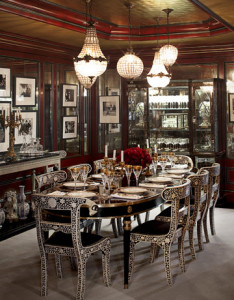
Newly redesigned dining room of Tommy Hilfiger -- The renovations cost the designer $50 million dollars. (Photo Credit: Harper's Bazaar)
• Tommy Hilfiger Renovates Home for $50 Million
Clothing designer Tommy Hilfiger recently renovated his two-floor NYC duplex for the hefty price tag of $50 million. This home improvement project has been in the works for two years to create “an old-world atmosphere complementing the old-world Plaza,” as Hilfiger stated to Harper’s Bazaar. The project involved a complete gut renovation of Hilfiger’s 6,000-square-foot duplex to create a glamorous/vintage European-vibe. And that it certainly is. The newly redesigned duplex now includes a gorgeous Maison Jansen dining room table, crystal chandeliers, a nautical-themed kid’s room complete with a ship bed and a French Renaissance-style turret featuring an Eloise mural by Hilary Knight. There is also a 20-piece collection by Andy Warhol, paintings by Jean Michel Basquiat and an American flag painting by Jasper Johns that Hilfiger is reportedly interested in buying. The home also features a private domed terrace, which overlooks Central Park that was redesigned with checkered flooring, a black sitting table and custom cut plants.
Check out more photos of Tommy Hilfiger’s Plaza home as featured in Harper’s Bazaar.

Jim Morrison's former dining room -- Listed for $1.1 million. (Photo Credit: Zillow.com)
• Jim Morrison’s Laurel Canyon Home for Sale
The Laurel Canyon home of the late Jim Morrison has recently been listed on the market for $1,199,000. Previously sold for $535,000 in 2001, the rustic 2,300-square-foot home is reportedly where Morrison did a lot of his song writing and hung out in the 1960s. The quaint home includes three bedrooms, open beamed ceilings, distressed wood floors, iron fixtures and a outdoor deck with a fire pit, gym and shower, as reported on Housing Watch. The new owner may also discover some of Morrison’s writings behind the wall of an indoor shower where he reportedly kept some of his poetry and songs – Strange Days, indeed.
• Cameron Diaz Buys Candice Bergen’s Beverly Hills Home
According to the Real Estalker, Cameron Diaz recently purchased Candice Bergen’s Beverly Hills home for $9, 447,500. Originally listed for $10,250,000, the 5,000-square foot home features four bedrooms, 4.5 bathrooms and a detached guest house that encompasses almost an acre of land includes another three bedrooms and two bathrooms. The sophisticated home also features hardwood and tiled flooring, high ceilings and an outdoor area with a pool, tennis court, gardens and a spa.
• Sacha Baron Cohen Lists Los Angeles Home for $2.9 Million
Sacha Baron Cohen aka the man behind “Ali G” and “Borat” recently listed his 2,806-square-foot home on the market for $2.9 million. The single-story Los Angeles abode features three bedrooms, 2.5 bathrooms, a detached guest room and a two-car garage. Other amenities in the house include hardwood flooring, a fireplace, French doors leading to the dining room, a modern kitchen with stainless steel appliances and white cabinets and an outdoor deck with a pool and spa.
• Ed McMahon’s Beverly Hills Home on the Market for $4.6 Million
The home of the late Ed McMahon is on the market $4.6 million. Originally listed in 2008 for the same price, the Mediterranean-style is located in a gated community in Beverly Hills that overlooks canyons and a sprawling yard. The California estate includes six bedrooms, 5.5 bathrooms, fireplace and a swimming pool. The seller (who was also a friend of McMahon’s) made significant home improvements on the 7,013-square-foot estate that faced foreclosure in 2008.
July 21st, 2010 by
Admin
Categories:
Celebrity Real Estate,
design and decorate,
Do It Yourself,
exterior projects,
foreclosures,
Home Improvement,
homes for sale,
interior projects,
Mortgages,
Moving,
Moving Day,
Moving Industry,
Packing,
Real Estate,
Relocation,
rentals Comments:
No Comments » ![rushop[1]](http://blog.relocation.com/wp-content/uploads/2010/07/rushop1-300x276.jpg)
The ornate abode of Rush Limbaugh -- Sold for $11.5 million. (Photo Credit: Corocan via the Wall Street Journal)
A few politicos made “the Celebrity Beat” this week. The “Lion of the Senate” aka the late Ted Kennedy’s Washington, DC home was recently placed on the market for $7,995,000. This massive Colonial-style estate includes five bedrooms, six bathrooms, a wine cellar and a personal gym designed by “the Terminator” or Governor Schwarzenegger, as he is referred to these days. On the right side of the political spectrum, Rush Limbaugh’s Upper East Side penthouse was sold for $11.5 million to an undisclosed buyer. Limbaugh has been stating he has wanted out of New York due to the city’s high property taxes — but if you have an $11 million dollar home, we are thinking you have sufficient funds to pay good-old Uncle Sam. To light things up a bit, comedians Cheryl Hines and Adam Carrolla are both selling their California homes. Hines’ home is situated in Brentwood overlooking the mountains; while Carrolla’s home overlooks downtown Los Angeles that was also personally designed and renovated by Carrolla.

Exterior Shot of the Late Ted Kennedy's Home -- Listed at $7,995,000. (Photo Credit: Zillow.com)
• Ted Kennedy’s Home on the Market for $7,995,000
The Washington, DC home of the late Ted Kennedy (Kennedy passed in 2009 after a long bout with brain cancer) is on the market for $7.95 million. Purchased in 1998 for 2.7 million, the 8,900-square-foot home includes five bedrooms, six full-sized bathrooms and two half baths, a wine cellar, an indoor and outdoor pool, a secret hideaway from the library and an indoor gym designed by no other than the movie star-turned-gobernador Arnold Schwarzenegger! Described as a “Colonial-style home” whose decor features long white columns, French doors, high ceilings, an outdoor terrace, gardens and a massive dining room that is customized to fit 50 people. Listed by Vicki Kennedy (Kennedys’ widow), who is seeking a smaller home in Washington, DC. According to the Wall Street Journal, the home is “quietly being shopped around” with no current buyer.

Exterior View of Cheryl Hines Brentwood Home -- Listed at $4,249,000. (Photo Credit: Paul Barnaby via the Wall Street Journal)
• Cheryl Hines Lists Brentwood Home for $4,249,000
Comedian and “Curb Your Enthusiasm” star Cheryl Hines recently listed her walled and gated Mandeville Canyon-area estate for $4,249,000.The 4,908-square-foot home sits on an acre of land that features stunning views of the nearby California mountains and new furnishings and renovations throughout the properties open-floor plan. If that isn’t enough, perhaps the homes six bedrooms, 5.5 bathrooms, a guest house and an outdoor pool with massive trees throughout the property may entice you to buy?
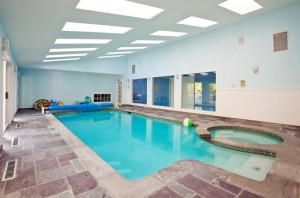
Joe Torre's home includes an indoor swimming pool -- Listed at$1,175,000. (Photo Credit: Zillow.com)
• Joe Torre’s Home Listed for Auction at $1,175,000
Joe Torre, former coach of the New York Yankees and current coach of the Los Angeles Dodgers has recently placed is New Rochelle, New York to be sold via a public auction. Located 30 minutes from Manhattan, the 6,500-square-foot home is listed at $1,175,000 that is expected to exceed the asking price. Some notable features about the two-level property includes six bedrooms, five bathrooms, an indoor pool and a three-car garage all of which is situated on 1.01 acres of land. The first level features a family room, a fireplace, and a large kitchen; while the second level has a master suite, guest rooms and a laundry room. Owners of the property will also become stockholders of the estate property company. For more information on the auction, visit BidOnTheCity.com.

Rush Limbaugh's master bedroom complete with a ceiling mural -- Sold for $11.5 million. (Photo Credit: Corocan via the Wall Street Journal)
• Rush Limbaugh Finds Buyer for NYC Penthouse
On another side of the political spectrum, conservative pundit Rush Limbaugh has found a buyer for his Upper East Side NYC penthouse. Originally listed for $13.95 million, the undisclosed buyer will pay $11.5 million for the condo, according to the Wall St. Journal. The full-floor penthouse overlooks Central Park and features 10 rooms, four terraces, a 30-foot-wide living room and a private elevator. The new buyer will also enjoy personal decorating touches of the conservative talk-show host such as ornate wall designs and a mural of clouds and birds in the master bedroom, along with various ceiling murals throughout the penthouse featuring palm trees and the beach. Limbaugh is relocating from New York due to the high property taxes, which he announced in February on his radio-show entitled “El Rushbo to New York: Drop Dead.”

Adam's Carolla's Home for Sale-- Listed at $1,395,000. (Photo Credit: the Luxist)
• Adam Carolla Lists Home for $1.3 Million
Comedian, Adam Carolla recently put his Beachwood Canyon home on the market. Carolla – who also owns two other properties in the Los Angeles-area – personally did all of the renovations on this three-bedroom as stated on the Luxist, “the home was totally rebuilt, piece by piece, like a restoration of an old car with modern equipment.” With a contractor background, Carolla spent at least $350,000 in home improvements on his 2,281-square-feet French-style home. The “ultimate bachelor pad,” that was “overbuilt,” as stated by Carolla, includes some interesting features such as an office, an indoor and outdoor bar, an updated kitchen with state-of-the-art appliances and a soundproof basement. The exterior of the house is also pretty impressive, which resembles a castle and overlooks downtown Los Angeles and views of the Hollywood sign.
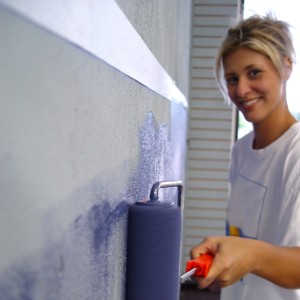
A new coat of paint can really spruce up your home.
By Kathy Woodard
Now that moving is over and you’re finally in your new home, it’s time to make it your own and add some of your style and personality. There are some simple home improvement fixes to change your new home that anyone can do. With one weekend and a little elbow grease, you can have your place in tip top shape in no time!
Paint:
Ok, I know this is an obvious one. The reason you hear painting as the number one DIY project for new homeowners so often is because it’s effective. And cheap. And easy. What more could you want? Make sure you plan out your color scheme for each room or the whole house before you ever visit a paint store. Many a new homeowner has ended up with what in the store appeared to be a bold, trendy color, only to discover that their new home was pink — really pink. Consider not just walls, but kitchen and bathroom cabinets, trim and doors as well. Plan, prepare and try out sample paints before you take a whole project on, but do paint!
Paint more…
Yea, I know, back to the paint thing. But did you know you can paint more than walls? By using a good primer and some polyurethane for protection, just about anything can be painted. Some ideas?
• Ugly bathroom countertops? If you can’t afford replacement counters, no worries. Prime, paint with a faux stone finish, then seal with polyurethane. Instant style update, without the remodeling price!
• Does your new kitchen come complete with avocado green appliances? You can spray paint them with auto spray paint to camouflage the 1970s look. If you paint a stove, make sure you use stove paint to protect the finish from the heat. Most home improvement stores carry a good brand.
• Yucky pink tile in the bathroom? Again, prime with a good primer, then paint. There are specialty paints for just this purpose, or you can use regular house paint and seal well with polyurethane.
• Even vinyl flooring can be painted. Keep in mind however, the higher the amount of traffic the floor receives, the more coats of polyurethane you will want to use for protection.
Add curb appeal:
You can increase the curb appeal of your new home in a day with some simple fixes. Replace your house numbers with something more in line with your personal style. Add a new mailbox, and update the light fixtures on your porch. Consider adding a window box or two. Use ornamental grasses in your box to give your home a contemporary feel different from the other houses on the block. Finally, paint the front door. Making these easy changes will brand your house as yours from all the way down the street!
Add storage:
Most homes never have enough storage, so think about making that one of your first home improvement projects. Closet and pantry systems are available at most home improvement centers and are easily installed by a beginning DIYer. Don’t forget the garage! Even adding simple shelves, hooks and hangars for tools and other items can double your storage space.
Quick changes:
There are also some simple projects you can do in less than an hour. Change out the cabinet hardware in the kitchen and bath. Choose new glass shades for all your ceiling mount light fixtures. Replace mismatched window treatments with inexpensive blinds. Add curtain sheers. Clean your windows inside and out to add sparkle to every room!
There you have it, simple fixes to change your new home, without needing a class in engineering or the bank account of a celebrity!
Want free home and garden ideas? Kathy Woodard is an author, columnist and home decorating expert. Visit her websites: TheBudgetDecorator.com and DecoratingYourSmallSpace.com.
More articles for your home improvement plans:
June 21st, 2010 by
Admin
Categories:
design and decorate,
Do It Yourself,
exterior projects,
Home Improvement,
interior projects,
Moving,
Moving Day,
Moving Industry,
Plan Your Move,
Real Estate,
Relocation,
Saving Money Comments:
No Comments » 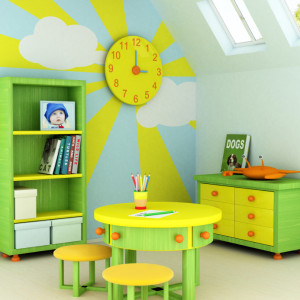
Shedding Some Light on a New Room
By Kathy Woodard
Congratulations, you have survived the moving process to your new home! Although your kids accepted the moving news, they may be feeling less than settled in — as well as a little scared and uneasy once they are in their new home. One of the best ways to help kids make the transition after a move is create a space that is all their own by decorating their room. This will help them create a new look for their new room, as well as offer a creative outlet and a way for them to express themselves.
Start talking about decorating your child’s new room before moving day. Allow the excitement to help with those difficult transitions. Brainstorm ideas with your child, so you can get an idea of what appeals to them!
As soon as you are settled into your new home, start making decorating your kids rooms a reality. Take them shopping in your new community to get ideas for their room décor. (This is a also a great way for them to start feeling more at home)
Create a plan with your child, not for them. You want to make sure your child is involved in the whole process. This way they will feel a real kinship with their new space, and taking ownership goes a long way toward getting over that homesick feeling for all they left behind at their old home.
Pick a theme and a color scheme with your child. This doesn’t have to be some cutesy cartoon character theme or anything commercial at all. Perhaps your 10-year-old wants a chic, stylish room painted in pinks and greens; while your toddler may want fish and mermaids. As soon as you identify your theme, write it down and have them make a drawing or list of what things they would like included in their room. Make sure they include the necessities like window coverings and storage, in addition to the beaded curtain they want as a closet door, or the disco ball they will insist will make a great bedroom lamp. Sit down together, and make choices as to what will be acceptable to you, and what you can afford.
Come up with creative ways you can make the room happen within your budget, and work on these home improvement projects together. Some money saving ideas?
• Sew two sheets together on three sides and insert their old comforter for an inexpensive duvet cover.
• Use paint to create the feeling in the room. Whether your child is quiet and shy, outgoing and vivacious, or somewhere in between, the right color scheme for their personality will make the difference between the room being a success, or a dud! Paint is cheap; use it ravishingly to create a fantasy for your child.
• Visit dollar shops for accessories for your child. Fun picture frames, storage baskets in bright colors, and themed toys to use for décor are all easy finds that will save you big money. Remember, stick to your theme!
• Craft and fabric stores are a gold mine for the DIY decorator. Use iron on hem tape to create simple curtains and throw pillows. Use craft foam in your rooms colors to cut out shapes that can be used as 3-D art on the walls.
• Visit thrift stores and yard sales to find rugs, lamps and accessories that can be renewed with a quick update of paint or fabric.
Finally, make a party of decorating day. Assemble all the ingredients and implement them all at once, instead of gradually. This gives a dramatic effect and underlines the importance this new space has for the child. Allow them to invite a couple of their new friends over to celebrate, or make it a family affair with a barbecue or the child’s favorite dinner.
Decorating for kids when you move to a new home can be a fun and a healthy transitional experience for both parent and child. Take advantage of the situation to make it a bonding experience you will both remember.
Want free home and garden ideas? Kathy Woodard is an author, columnist and home decorating expert. Read more articles written by Kathy on the websites TheBudgetDecorator.com and DecoratingYourSmallSpace.com.
June 14th, 2010 by
Admin
Categories:
design and decorate,
Do It Yourself,
exterior projects,
Home Improvement,
Moving,
Moving Scams,
Packing,
Plan Your Move,
Plan Your Relocation,
Relocation,
Relocation Data,
Saving Money Comments:
No Comments »

Start small and your garden will grow
By Kathy Woodard
Whether you are moving to a new home or have lived in your residence for a long time, there are certain home improvement projects that can spruce up your landscape and add value to your property, while also being an enjoyable activity for you and your family. As the top hobby in the country and a fun home improvement project, gardening beautifies your property, relieves stress, offers good exercise and even supplies you with fresh herbs for your dinner. Not to mention, it allows you the opportunity to commune with nature in your own backyard! Not knowing how to garden can stop many people from picking up that first trowel or planting that gorgeous rose they have long admired. No need to fear those hydrangeas, beginners can easily learn how to garden by following these simple tips.
Learn, learn, learn.
There are so many resources now for learning about gardening. Libraries and book stores overflow with gardening books and the internet has a wealth of information. Consider joining a local gardening club or online forum. Start a notebook where you can keep magazine pages of yards or plants you’ve admired, notes from online searches, or snapshots of your yard, both before you start gardening and as you progress.
Don’t bite off more than you can chew.
The biggest mistake beginner gardeners make is to start with too large a garden, or to use plants that require an expert’s care. You can always add more to your garden as you gain experience; nothing is as off putting to a newbie as a huge garden that turns, practically overnight, from gorgeous blooms to overrun weeds. Talk about taking the bloom off the rose! It’s common to quit gardening after a bad experience, so don’t let this mistake choose for you. Start small. Start simple.
Plan… but be flexible.
Make sure you spend some time drawing out a plan for your new garden. Make lists of plants that you would like to try, and research what times of year they bloom or fruit and what their special needs are. Group plants with similar needs together. Make sure shade plants are planted in shade, and sun plants in the sun. All that have been said don’t be afraid to try something new. Sometimes a volunteer plant will pop up and look just gorgeous right where it is. Other times you will have chosen a certain plant for a site and find that even after all your preparation, it doesn’t do well there. So, move it! Head to the nursery with a list, but don’t be afraid to substitute a plant for a new find. (Be careful with this one, you may come home with twice the plants you need!) Also, make sure that you purchase the proper gardening tools and don’t be afraid to ask for help!
Find a passion within your garden.
Once you learn a bit about how to garden, most beginners find a niche in gardening that ignites their passion. Find it, and enjoy it. Wildlife gardening, growing your own food, growing flowers for your own arrangements or water gardens complete with koi and living water plants are common passions. Letting yourself find that connection with the outdoors that speaks to you will only enhance your love of gardening all the more.
Consider hiring help.
If you love the idea of having a garden, or have gotten in a little over your head, hiring a gardener can be the perfect solution.
• Decide what kind of help you need. Do you need just regular mowing and fertilizing, while you take care of the flower beds? Do you want your gardener to do it all? Are you somewhere in between? Knowing what you need and what you can afford is the first step.
• Ask for reference from family and friends.
• Choose a garden service you can communicate with well. The last thing you want is for your new “help” to cut down the prize hydrangea you have been growing all season, or to use pesticides on your organic vegetables.
Learning how to garden is a fun and healthy hobby for beginners. Just follow these tips to get turn all your fingers into “green thumbs”!
Want free home and garden ideas? Kathy Woodard is an author, columnist and home decorating expert. To read more articles by Kathy, visit The Budget Decorator and The Garden Glove.